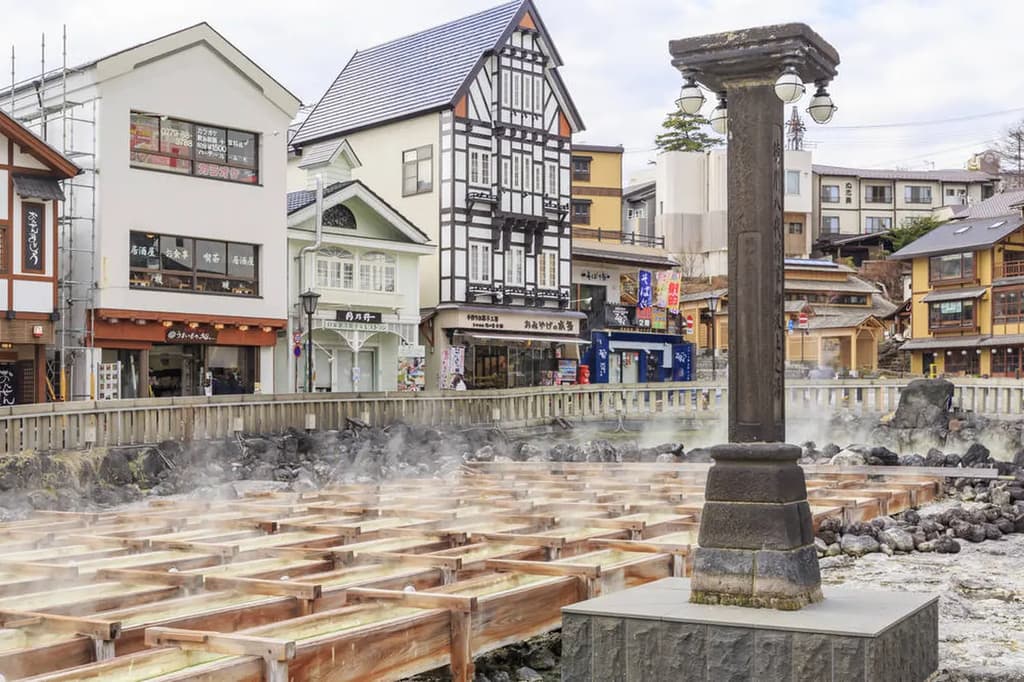Kusatsu Onsen is a popular hot spring tourist destination that has been ranked No. 1 in the hot spring ranking.Visitors can stroll through the hot spring town centering on Yubatake (hot water field), a symbol of Kusatsu, where they can feel the hot spring atmosphere, and experience the unique hot spring culture. Just a short walk away, you can visit places where you can feel the power of the earth and the blessings of the hot springs, as well as places with rare and spectacular views. Here is a summary of the attractions of a trip to Kusatsu Onsen, from the local cuisine you can try while enjoying the hot springs to information on access, transportation, and events.
What is Kusatsu Onsen (草津温泉)?
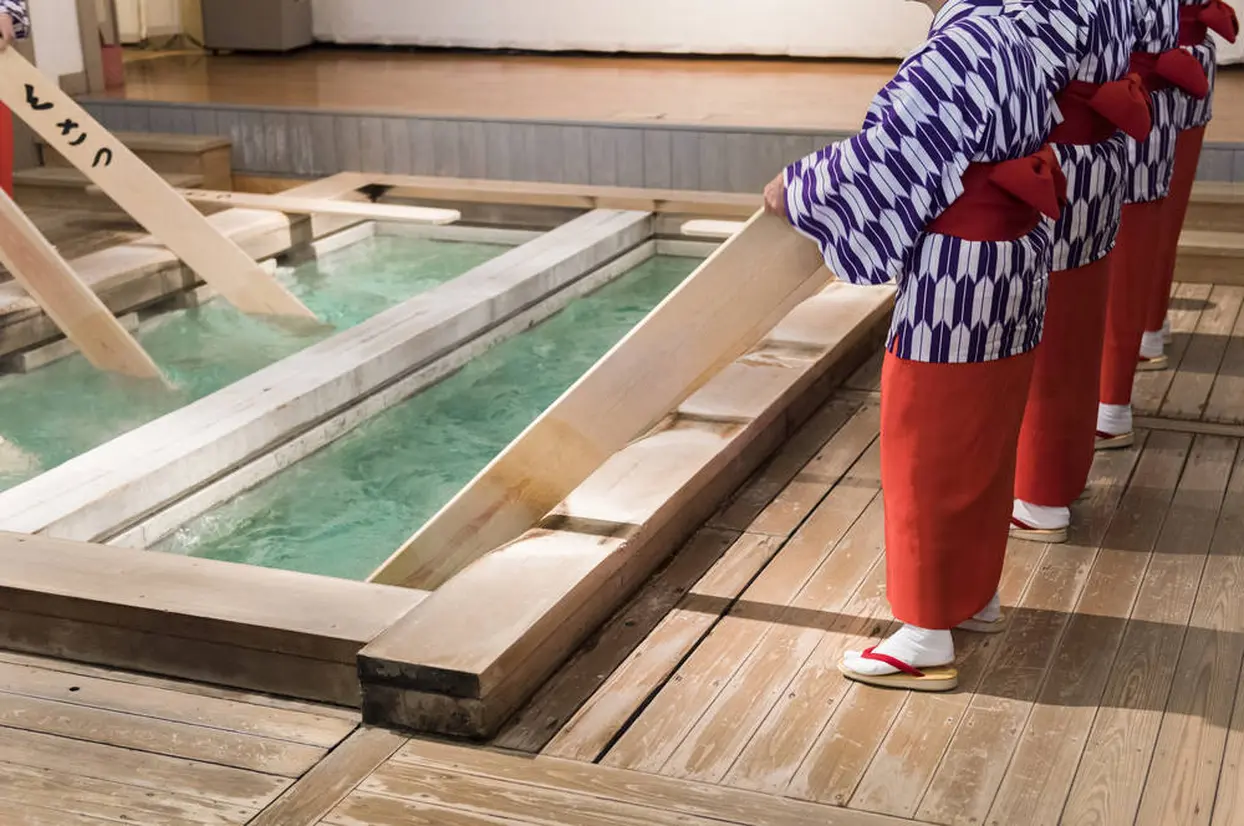
Kusatsu Onsen, one of the most famous hot springs in Japan, is a popular hot spring tourist destination that was ranked No. 1 in the “Hot Springs to Visit” popularity rankings. Legends of the discovery of the hot spring by historical figures such as Yamatotakeru no Mikoto (Prince Yamatotakeru) and Shogun Minamoto no Yoritomo are still remain, a historic hot spring.
The output of natural hot spring water is the largest in Japan, and its amount is equivalent to about 230,000 drums of water in one day. This is the very reason why you can enjoy “natural hot spring water flowing directly from the source” in the accommodations and hot springs of Kusatsu Onsen.
The hot spring water of Kusatsu Onsen is so wonderful that it is said to cure any disease except love sickness. The highly acidic nature of the spring is characterized by its excellent sterilizing and anti-inflammatory properties.
At the symbolic Yubatake, visitors can feel the power of the earth. The atmosphere of the hot spring resort town that spreads out around Yubatake is also one of the major attractions of Kusatsu Onsen.

The region is located on a plateau 1,200 meters above sea level, and the average annual temperature is 7°C. Even in summer, the temperature is rarely higher than 25°C, making it a comfortable climate. Visitors can enjoy leisure activities in the refreshing breezes of the plateau, and in winter, powder snow falls and visitors can enjoy winter sports such as skiing on the high-quality snow.
Located in the northwestern part of Gunma Prefecture, it is only an hour away from Karuizawa, one of the famous tourist destinations in Nagano Prefecture.
Highlights of Kusatsu Onsen
Take a walk around Yubatake
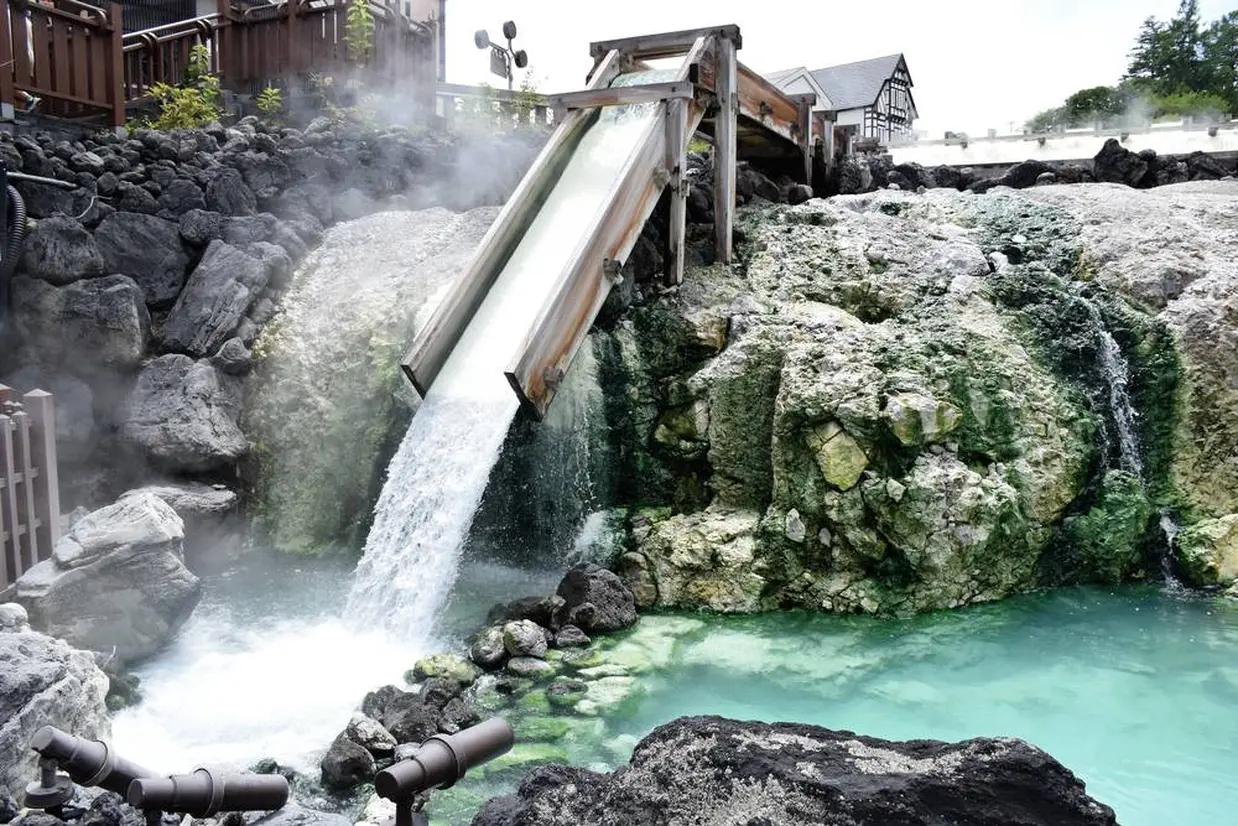
A five-minute walk from the Kusatsu Onsen Bus Terminal, the entrance to Kusatsu Onsen, you will see Yubatake, one of the most popular tourist attractions in Kusatsu Onsen. This is a traditional method for cooling the hot spring water flowing from the source to take advantage of the wonderful spring water quality. The hot water cascading down from the Yutaki Waterfall depicts the Kusatsu Onsen’s amazing spring water output.
The surrounding area is maintained as a park, and is close to Yukemuri-tei, where you can enjoy footbaths, Toji Hiroba, a perfect resting place, and Netsunoyu, where you can watch Kusatsu’s famous Yumomi show.
There are also souvenir stores and other stores, so take a stroll while feeling the hot spring atmosphere.
Enjoy hot water from 6 representative Kusatsu hot spring

Kusatsu Onsen has numerous sources, six of which are major hot springs.
Yubatake natural hot spring source (湯畑源泉)
The Yubatake natural hot spring, located in the center of the hot spring resort, flows from a wooden troughs to a hot spring waterfall, so that the hot water is naturally cooled by the outside air and distributed to various bathhouses and inns. It is characterized by its high content of natural “yunohana” (a component of hot spring water), which is used in bath salts and other products.
Shirohata natural hot spring source (白旗源泉)
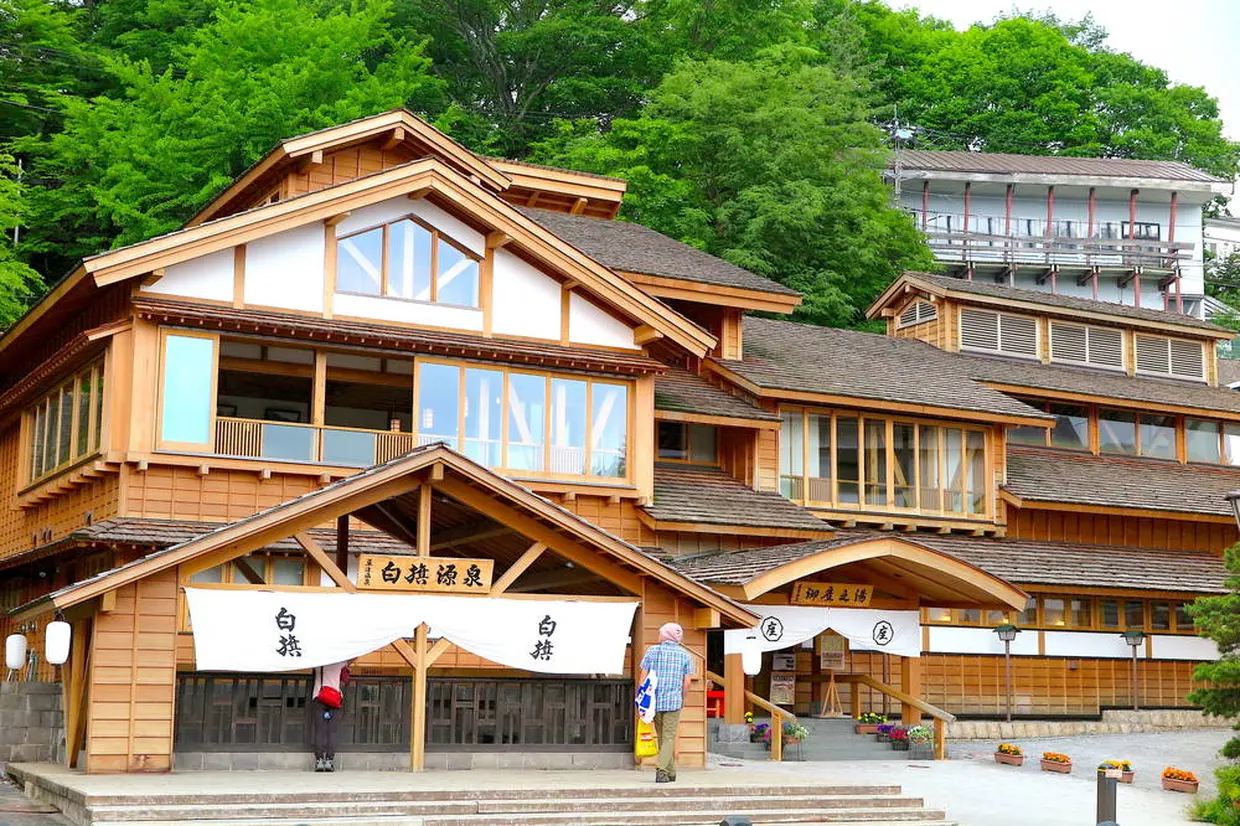
The Shirohata natural hot spring source flowing next to the Yubatake is the oldest source in Kusatsu Onsen, and is said to have been discovered by Minamoto no Yoritomo. Shirahata-no-yu, a public bathhouse, draws hot water from this source.
Jizo natural hot spring source (地蔵源泉)
The Jizo hot spring source also contains great elements, and has long been said to be effective for eye diseases. There is also a small Jizo Yubatake nearby, which can be entered at the Jizo no Yu public bathhouse.
Nikawa natural hot spring source (煮川源泉)
The clear water of the Nikawa hot spring is not supplied to ryokan, and can only be enjoyed at the Otaki no Yu public bathhouse.
Bandai natural hot spring source (万代源泉)
The Bandai natural hot spring source, flowing on a hill, a short distance away from the hot spring resort, currently boasts the largest output of hot water in Kusatsu. While the water from other sources is around 50°C, the Bandai hot spring is considerably hotter at approximately 94.5°C, so a heat exchanger is used to lower the temperature. In addition to the Sainokawara Rotenburo (open-air bath), which offers an overwhelming sense of freedom, it is also used in many lodging facilities.
Sainokawara natural hot spring source (西の河原源泉)
Located closer to the hot spring resort than Bandai Onsen, Sainokawara hot spring flowing from various locations in Sainokawara Park. Visitors can watch the hot spring water flowing as they stroll through the park.
Although we do not recommend that you enter all six of the above hot springs in a single day, you can enjoy Kusatsu Onsen even more if you know the characteristics of each hot spring. The water contains a lot of sulfur, which may discolor towels and other items, so be careful.
Enjoy the illumination of Kusatsu Onsen

Yubatake is beautifully illuminated at night. The lights of the surrounding stores and the steam rising from the hot spring are fantastic. This is also the site of a candlelight event called “the light of a dream,” in which more than 1,200 candles are gently lit on the steps of Kosenji Temple in front of the Yubatake.
The SainoKawara street and the Sainokawara open-air bath are also lit up at night. Enjoy strolling at night in a different atmosphere from that of the day.
Enjoy seasonal leisure activities
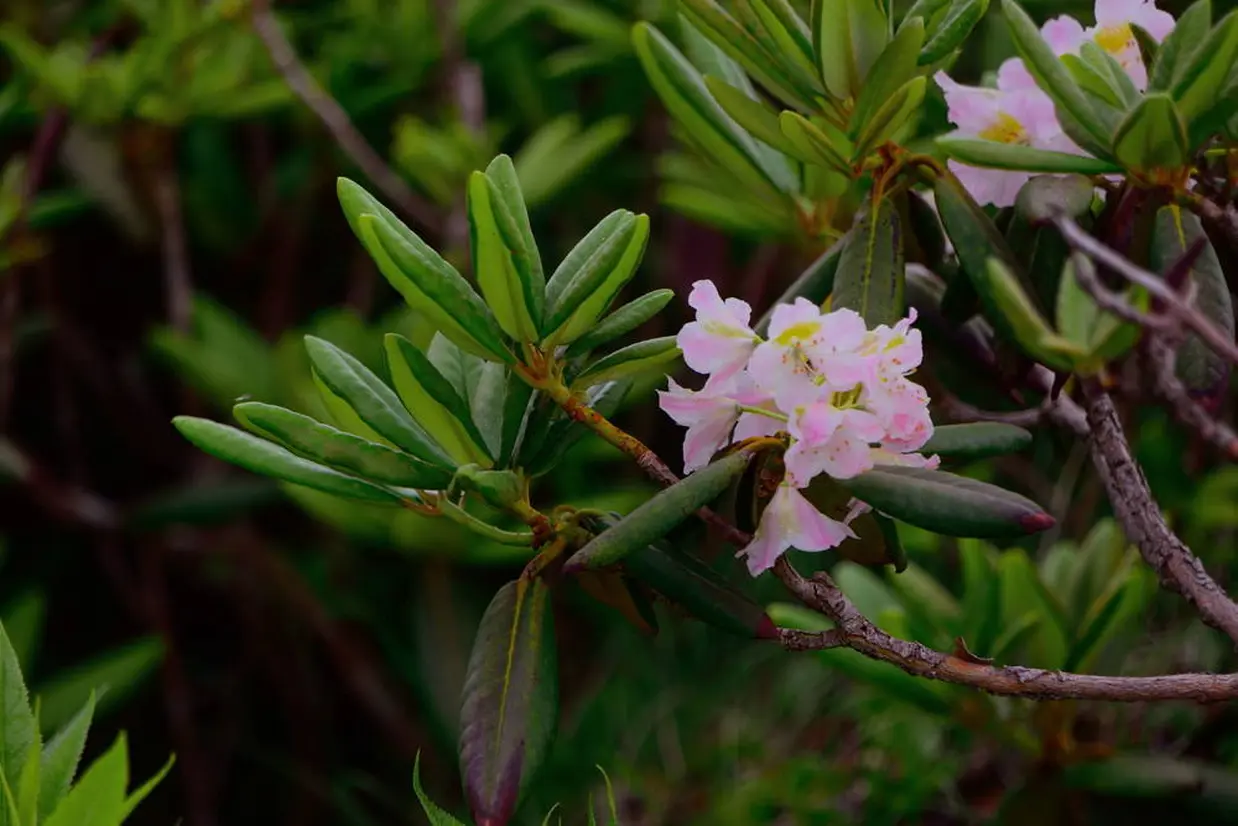
Kusatsu Onsen is located on a plateau at an altitude of 1,200 meters, with 2,000-meter-high mountains towering around it. The average temperature is lower than that of the plains, allowing visitors to enjoy summer and leisure activities.
The Tenguyama slope at Kusatsu Onsen Ski Resort can be used as the “Tenguyama Play Zone” during the green season when there is no snow.Visitors can come with a picnic, relax in the open space, and enjoy summer sports such as grass skiing and putt-putt (mini-golf), as well as various attractions that allow them to play while feeling the highland breeze. The lifts on the slopes are in operation during the summer, and you can also enjoy a view of the green mountains from the top of Mt. In winter, visitors can enjoy skiing and snowboarding on the smooth powder snow.
Kusatsu Onsen is also included in Joshin’etsukogen National Park, which straddles the three prefectures of Gunma, Nagano, and Niigata, and a short stroll from the hot spring resort will bring you close to spectacular natural scenery, including the alpine rhododendrons and the Yoshigadaira wetlands, a treasure trove of rare plants and animals even in the world. The area is also a great place to take a stroll while taking in the spectacular natural scenery.
Experience a variety of hot springs
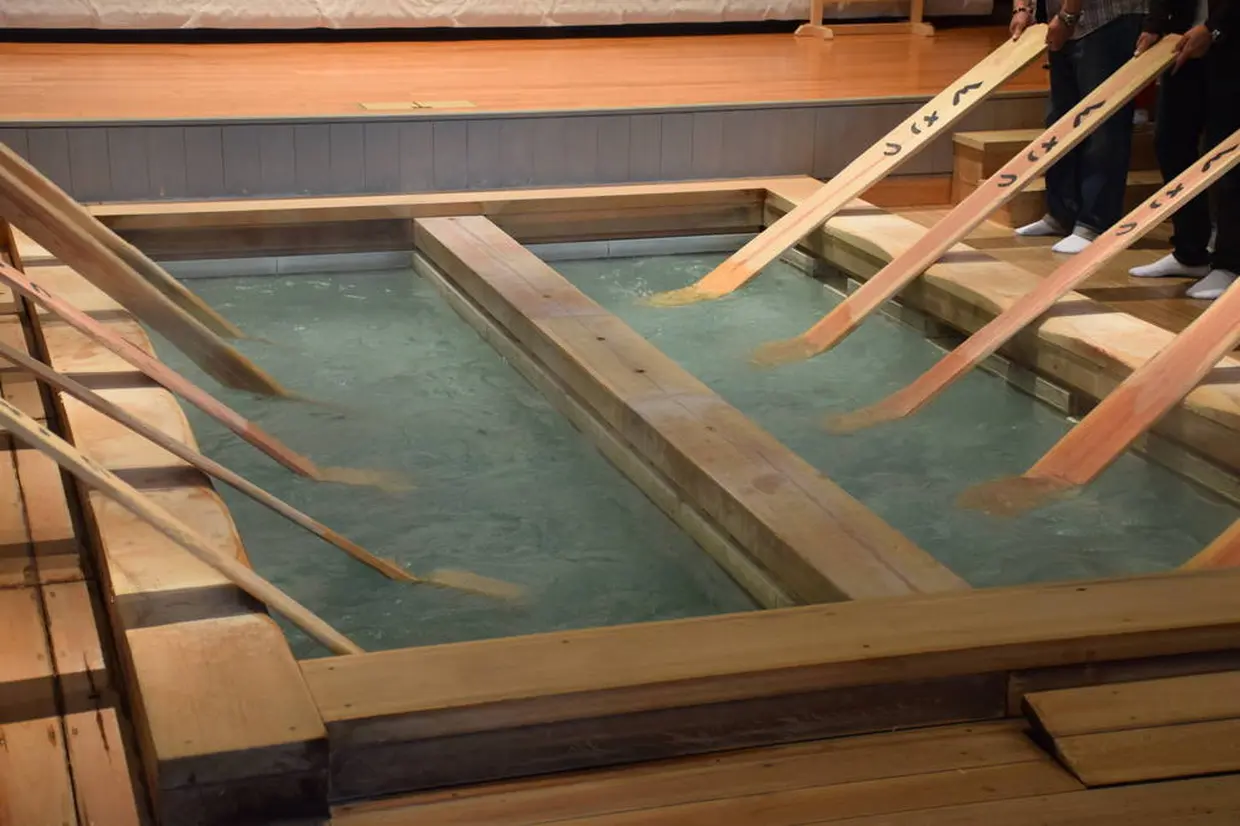
Kusatsu Onsen has developed its own bathing method since the Edo period. One of the most representative of these methods is “Yumomi” (stirring the hot spring water with wooden paddles). The sight of long paddles being used to stir the hot spring water is often shown on Japanese TV and other media. Yumomi is a method invented to utilize the benefits of hot spring water from sources as it is, without diluting it, which can reach temperatures of nearly 50°C.
Wooden paddles are placed in the hot spring water to lower the temperature and soften the water as well as provide a preparatory exercise before taking a bath. At Netsu no Yu near Yubatake, where visitors can observe a yumomi show, visitors can actually experience yumomi.
Awase-yu (合わせ湯), a method involves soaking in four or five tubs of varying water temperatures to acclimate oneself to the hot water is another bathing method that has been handed down from generation to generation in Kusatsu Onsen. In order to bathe at the proper temperature without diluting the richness of the hot spring water with extra water, the hot spring water naturally cools down as it passes from a high-temperature bathtub (45°C-46°C) through about four bathtubs to a low-temperature bathtub (38°C-40°C).
Start with the lowest temperature “Nuruyu” and let your body get used to the bath. You can experience Awase-yu at the bathtub of Otaki no Yu.
At Gozanoyu (御座之湯) near Yubatake, yukata are available for rent. Why not change into a colorful and cute yukata and go for a stroll in the hot spring town? Many kinds of yukata and decorative sash belt are available.Men’s yukata are also available, so couples can enjoy the experience together. Geta (Japanese clogs), bamboo basket bags, and even dressing service are included in the price, making the yukata experience easy.
Atsunoyu (熱乃湯) WebsiteOtakinoyu (大滝乃湯) WebsiteGozanoyu (御座之湯) Website
Popular Tourist Areas
Areas around Yubatake

The area around Yubatake, the symbol of Kusatsu Onsen, is lined with souvenir stores and restaurants, and is home to many hot springs, giving the area a particularly hot spring atmosphere. From the Kusatsu Onsen Terminal, the gateway to Kusatsu Onsen, it is only a five-minute walk. The tremendous amount of hot water flowing from the hot spring fields and the white steam rising from the hot springs will make your trip even more fun!
Yubatake (湯畑)

Located in the center of the hot spring resort, Yubatake, one of the sources of Kusatsu Onsen, flows out 4,000 liters of hot spring water per minute while emitting a white steamy vapor. The majestic appearance of the Yubatake is a true symbol of Kusatsu Onsen. Around the hot spring field is a park where visitors can enjoy strolling along a tile-paved walkway and benches. It is a popular starting point for sightseeing in Kusatsu Onsen and a popular spot to enjoy walking around the town after taking a bath.
Yubatake is a clever way of utilizing the hot spring water of Kusatsu Onsen. First, the hot water from the source flows down seven wooden troughs. This cools the hot water down moderately and creats “yunohana”, crystalline compounds, a natural bath salt. These “yunohana” are sold as precious souvenirs.
The hot water then flows down the Yutaki Waterfall at the edge of the hot spring field and distributed to the public bathhouse Chiyo-no-yu and ryokan. Thanks to this system, the hot spring water does not need to be diluted with water, and can be enjoyed as it is.
Yukemuritei (湯けむり亭)
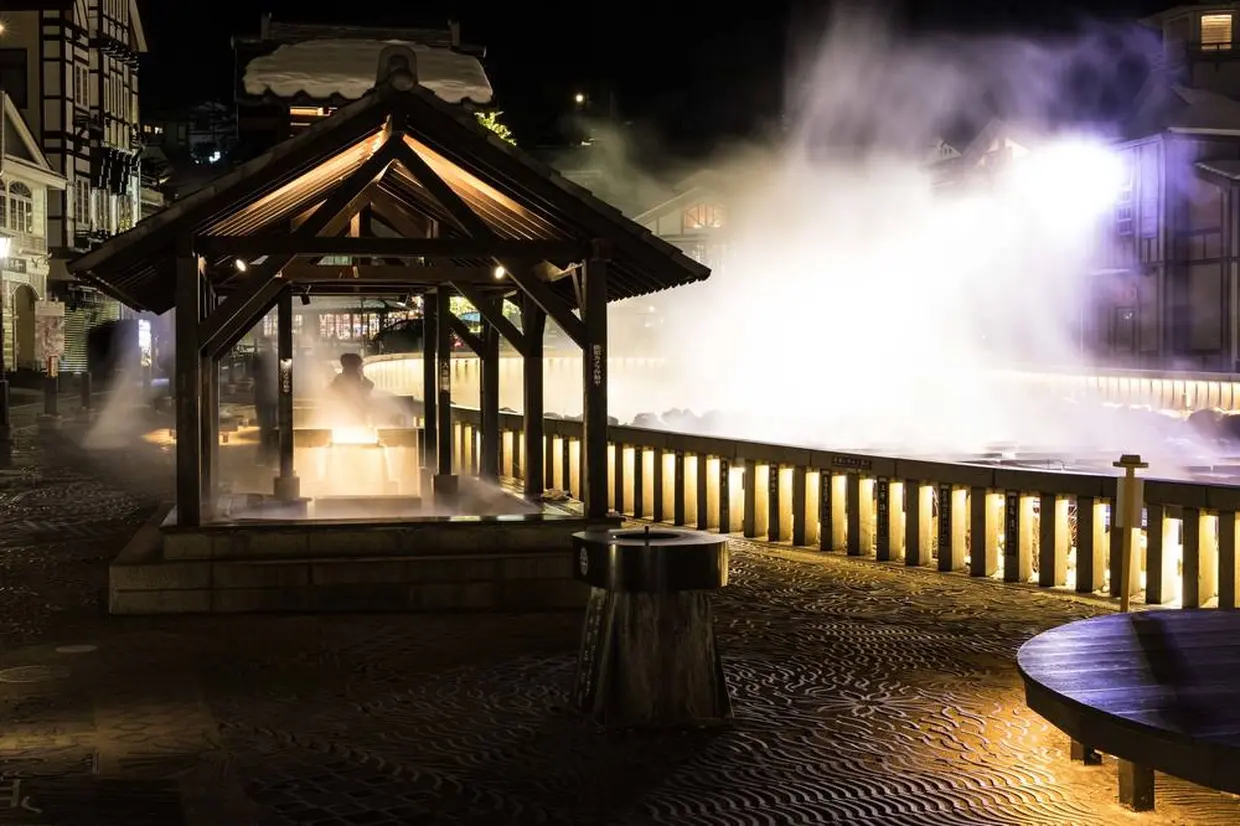
Yukemuritei is a spot where visitors can casually enjoy the hot water of Yubatake with footbaths, built with cypress trees beside Yubatake. A public bathhouse Matsu-no-yu was located here in the Edo period (1603-1868), and the building is reproduction of what it looked like in those days.
The hot, highly acidic water of Kusatsu warms your body even if you just soak your hands and feet for a few minutes. It is free of charge and can be used freely 24 hours a day.
Toji Hiroba (湯路広場)
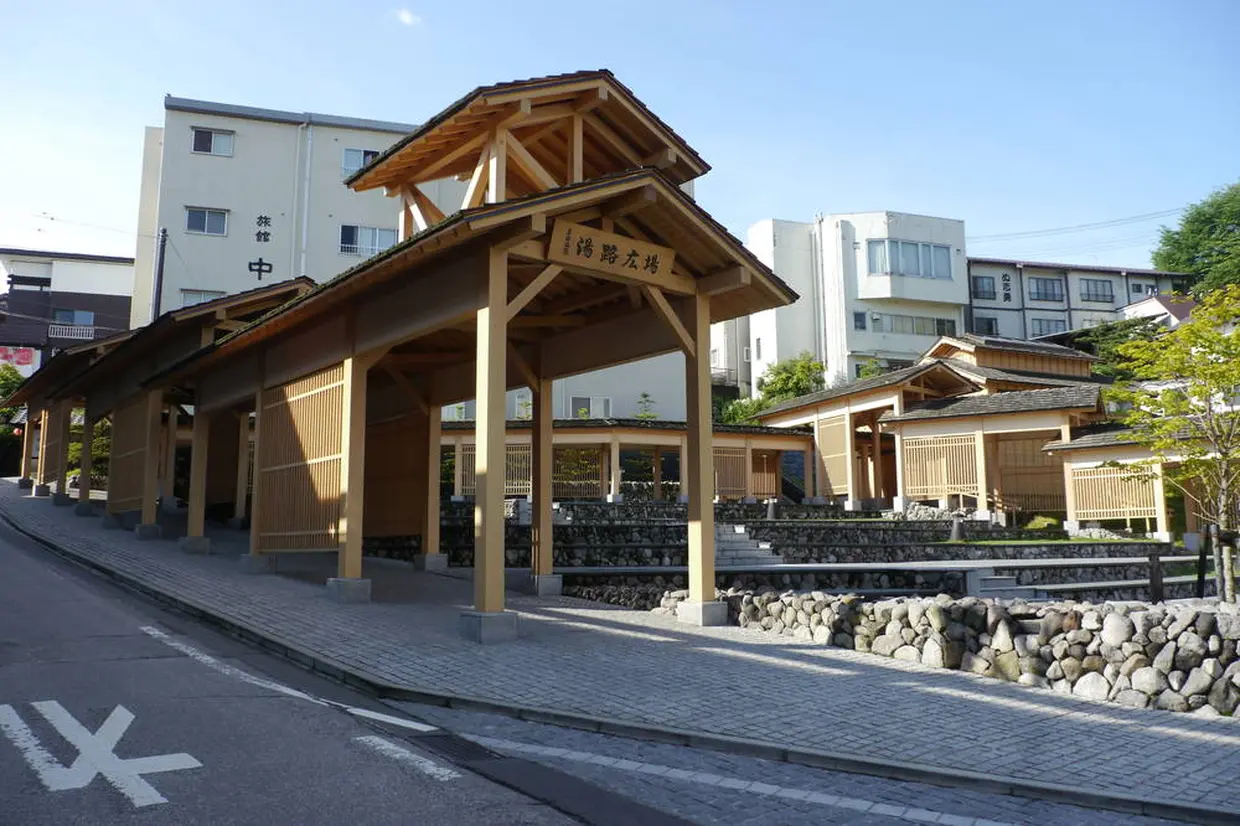
Toji Hiroba, located near Yubatake, is a Japanese-style plaza with a retro Showa-period atmosphere reminiscent of terraced rice field. It is also used as a venue space for various events held in Kusatsu Onsen.
Visitors can walk along the corridor in yukata with the sound of geta (Japanese wooden clogs), or sit and rest on the stair-like plaza.
Gozanoyu (御座之湯)
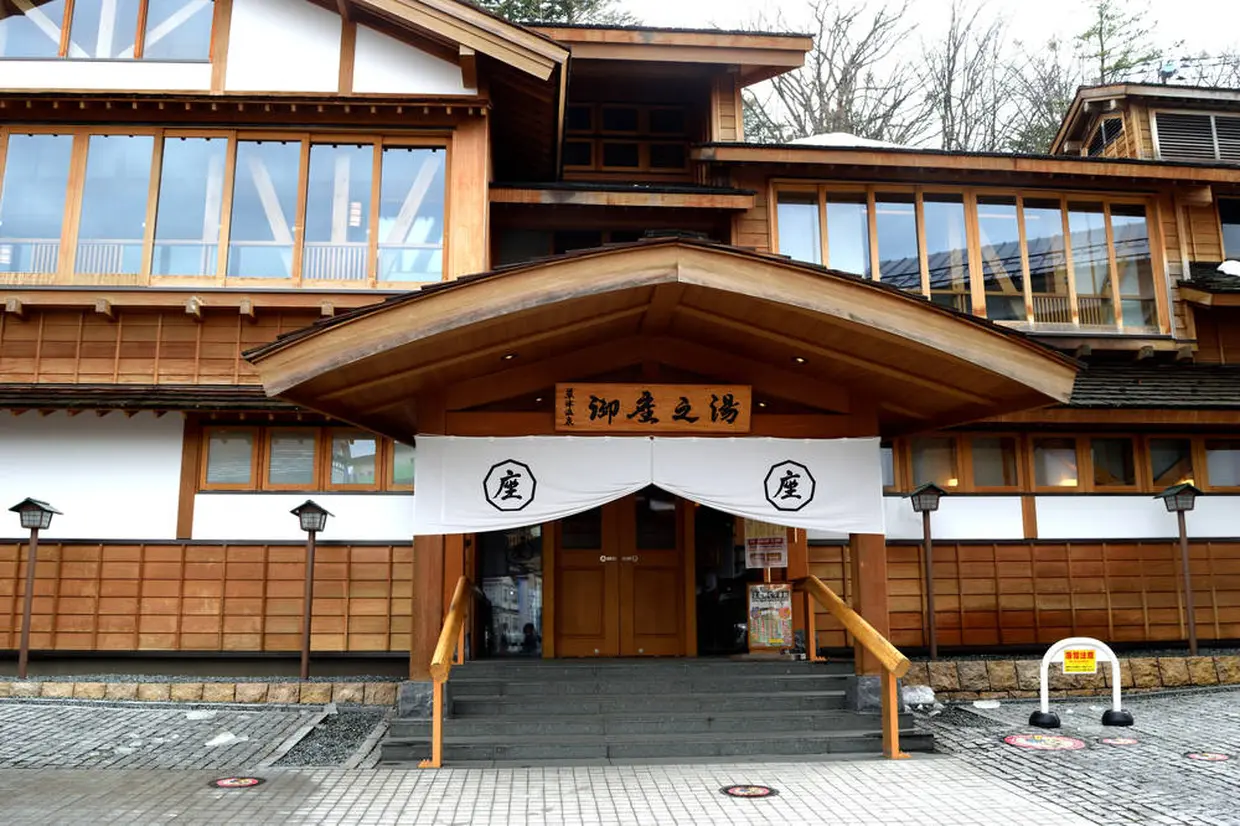
Gozanoyu is a facility where visitors can enjoy bathing. It is a reproduction of one of the public bathhouses that existed in the Yubatake area from the Edo period to the Meiji period.
The building is focused on the atmosphere of the period, and the exterior features white plaster walls and wood shingle roof.There are two bathhouses, and inside each bath you can enjoy hot water from two different sources: Yubatake and Bandai. The men’s and women’s baths are switched on a daily basis, so be sure to visit when staying at Kusatsu Onsen.
There is also a yukata rental plan for outings. You can choose from more than 20 types of yukata and 30 types of decorative sashes for women and more than 10 types of yukata for men to explore Kusatsu Onsen. They will also dress you and, of course, you can take a bath.
Shirahatanoyu (白旗の湯)
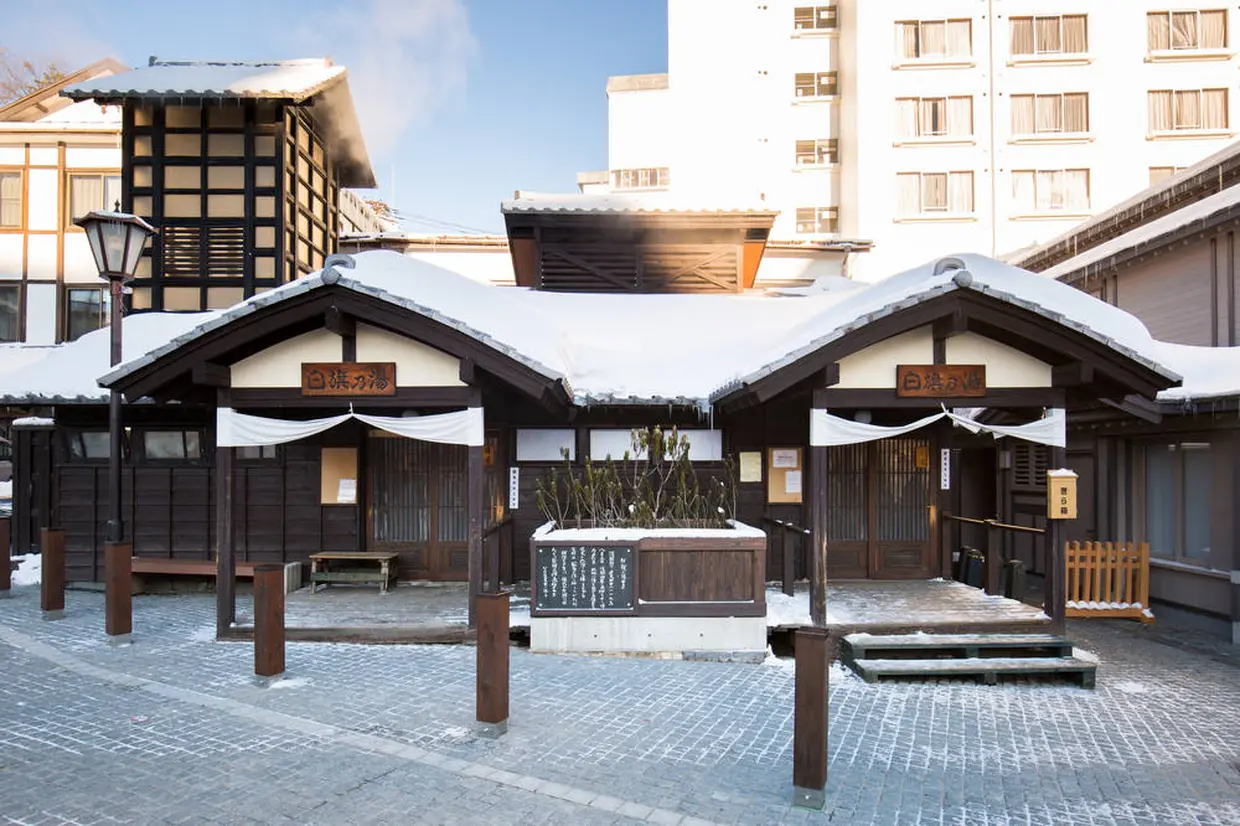
Shirohatanoyu, located near Yubatake, is the largest public bathhouse in Kusatsu Onsen where you can enjoy hot water from the Shirahata source. The public baths are used by the locals for their daily lives and are managed by the locals, so please use the baths with good manners. Please note that there are no lockers with locks.
We invite you to enjoy the hot springs while having fun interacting with the locals. It is open late, until 11:00pm at night, and you can enter for free.
Chiyonoyu (千代の湯)
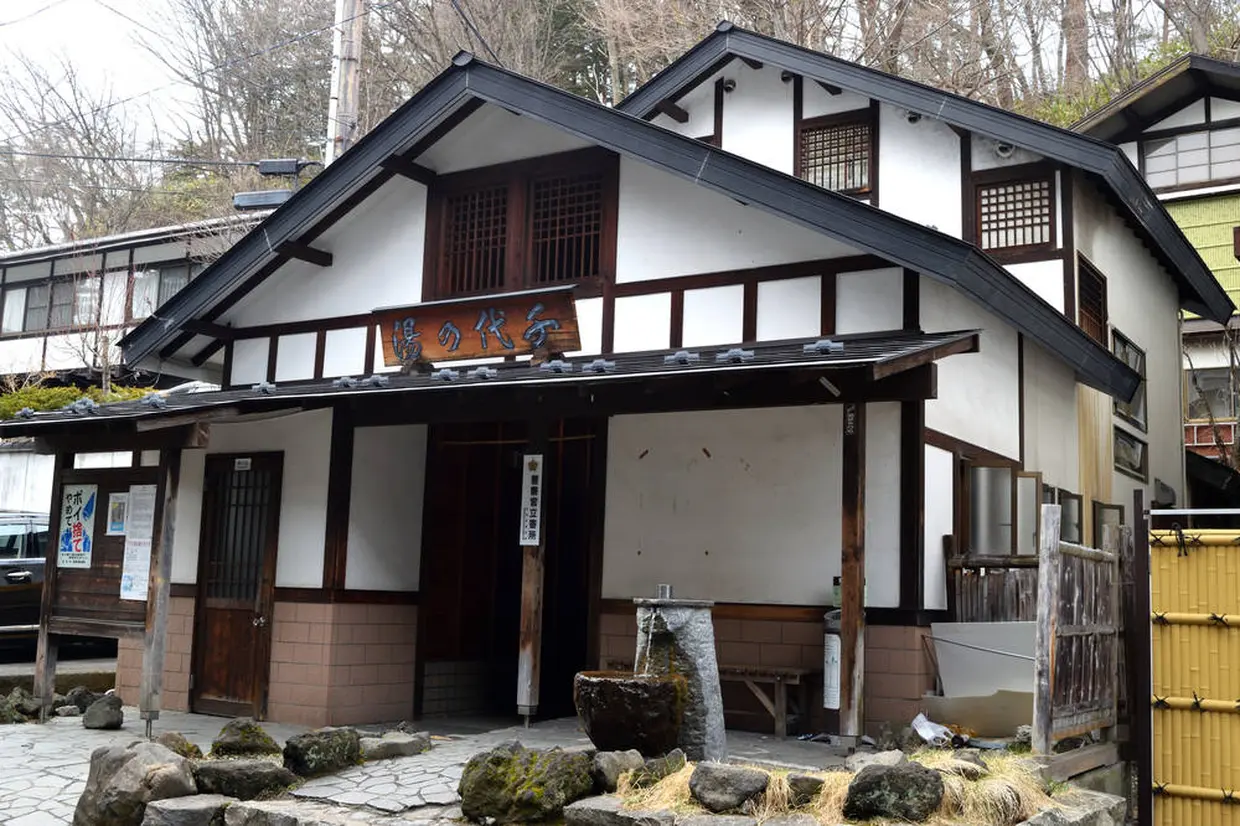
Walking from Yubatake Yutaki Waterfall to Takishita Street, you will find Chiyo no Yu in about 2 minutes. This is a public bath where visitors can enjoy hot water from the Yubatake spring source, and bathing is free of charge.
Netsunoyu (熱乃湯)
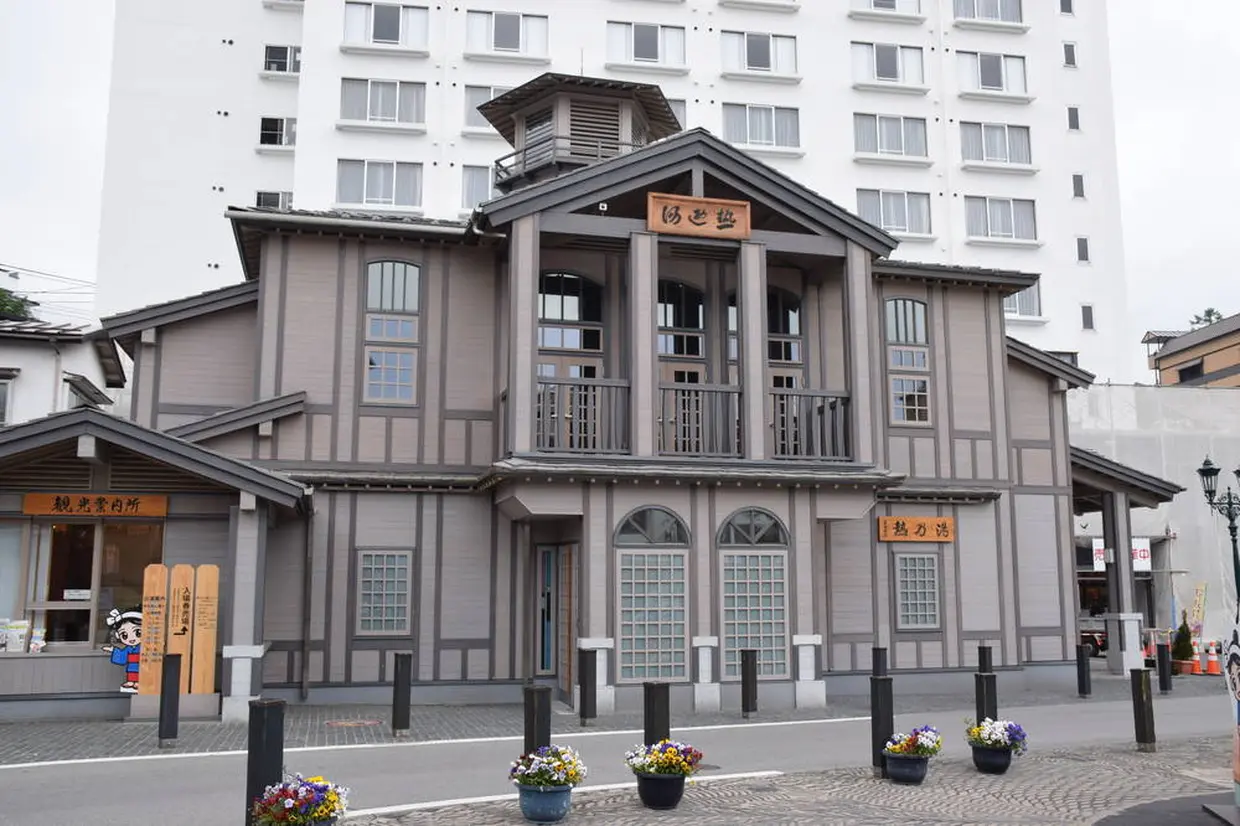
Netsunoyu is a two-story building in the Taisho-roman style located right in front of Yubatake. The inside of the facility has an atrium and the smell of wood wafts through the air. Visitors can watch a show in which the Yumomi Girls perform Kusatsu Onsen’s famous Yumomi with songs and dances, and you can even experience Yumomi.
Honke Chichiya Yubatake (本家ちちや 湯畑店)
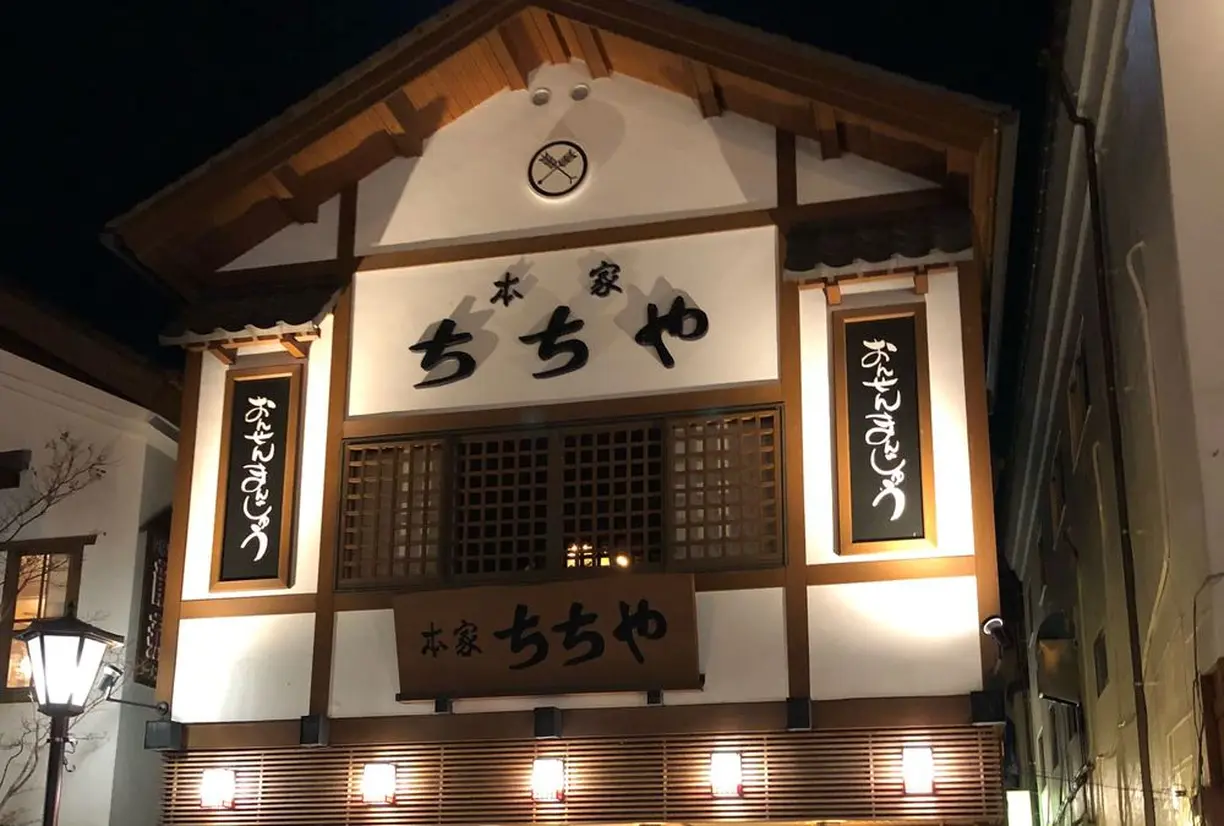
Honke Chichiya is a store that produces and sells onsen manju, a popular souvenir of Kusatsu Onsen. Two types of onsen manju are available Chamanju, a traditional onsen manju made with moist brown sugar dough, wrapped in tsubu-an (sweet bean paste) and steamed, and Nishoku-an manju (white), a two-color sweet bean paste made with chestnut paste and red bean paste and wrapped in white dough.
There are three stores in Kusatsu Onsen, but the Honke Chichiya Yubata Store, located right in front of Yubatake, is open until 9:00 pm. This is the only store that sells freshly steamed onsen manju over-the-counter, and you can enjoy eating them while strolling through the onsen district.
Yoritomo
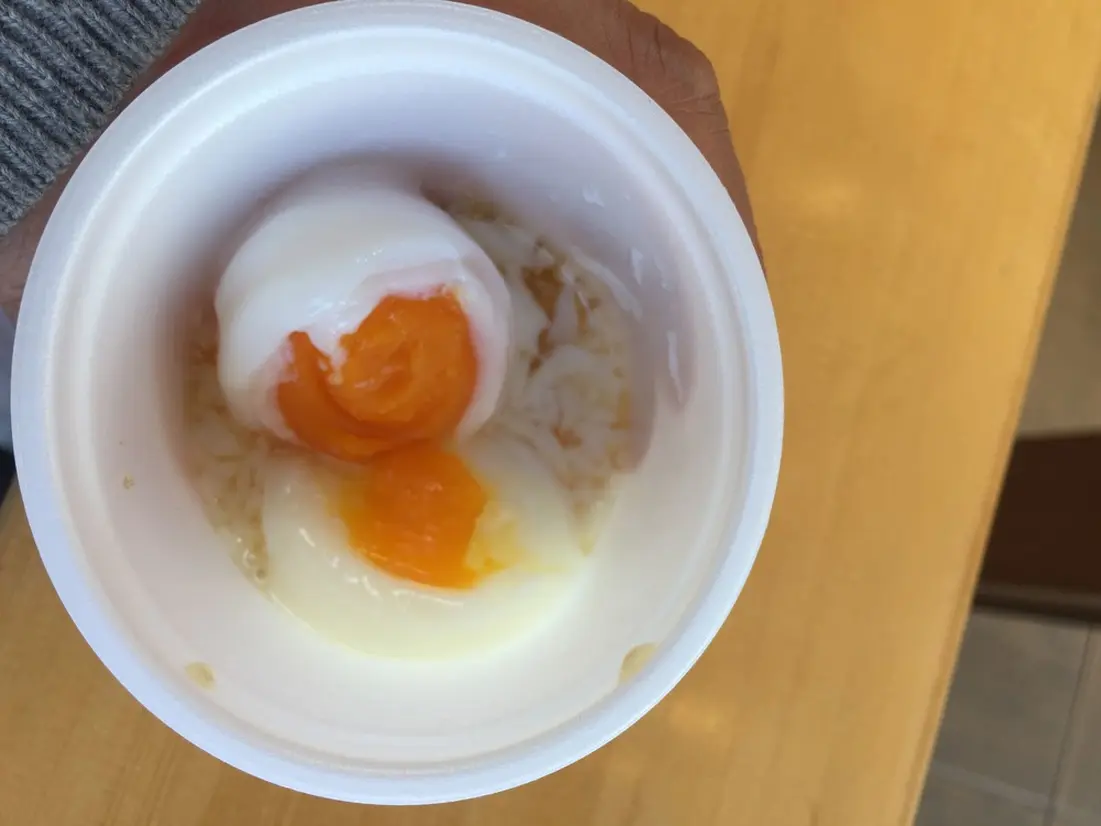
Located just in front of the Yubatake footbath and Yukemuri-tei, Yoritomo Yubatake Shop sells a wide variety of health-friendly pickles made with less-saltiness, domestically produced ingredients. Other souvenirs include sweets, spices and dressings, and specialties from Gunma and Kusatsu.
The store’s signature Onsen eggs have a rich flavor. A box of 10 eggs can be taken home as a souvenir, but a single egg in a cup, perfect for eating on the spot, is also available and very popular. The cups also come with a spoon, so you can eat them on the spot.
Jizo no Yu (地蔵の湯)
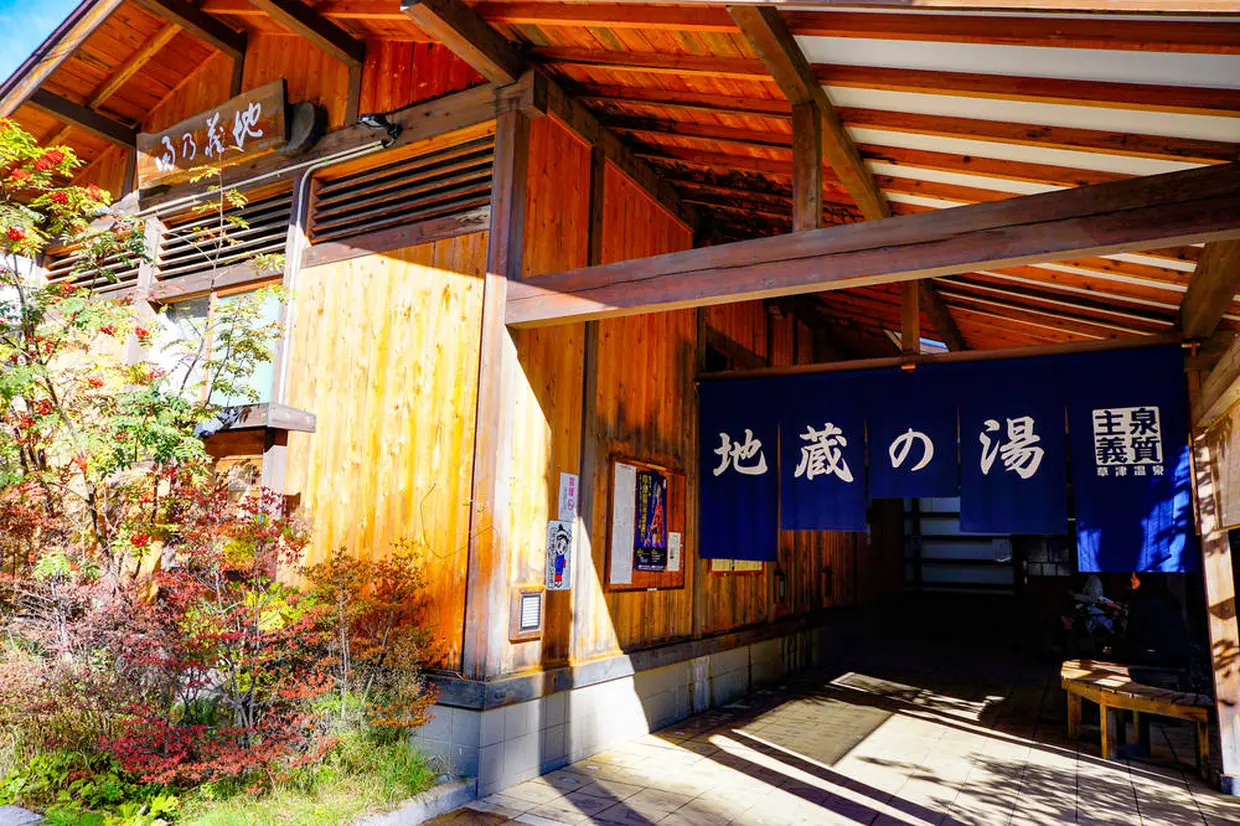
At Jizo no Yu, located about a 3-minute walk from Yubatake, you can bathe in the slightly cloudy water of the Jizo hot spring source that flows from the side of the Jizo Hall. It is a free public bath.
Jizo no Yu-mae Footbath

The Jizo no Yu Mae footbath, which is free and available 24 hours a day, is located in the plaza in front of the entrance to Jizo no Yu. Visitors can take a footbath while enjoying the view of Jizo Hall’s Jizo statue and the small hot spring field of Jizo source.
Kosenji Temple (光泉寺)
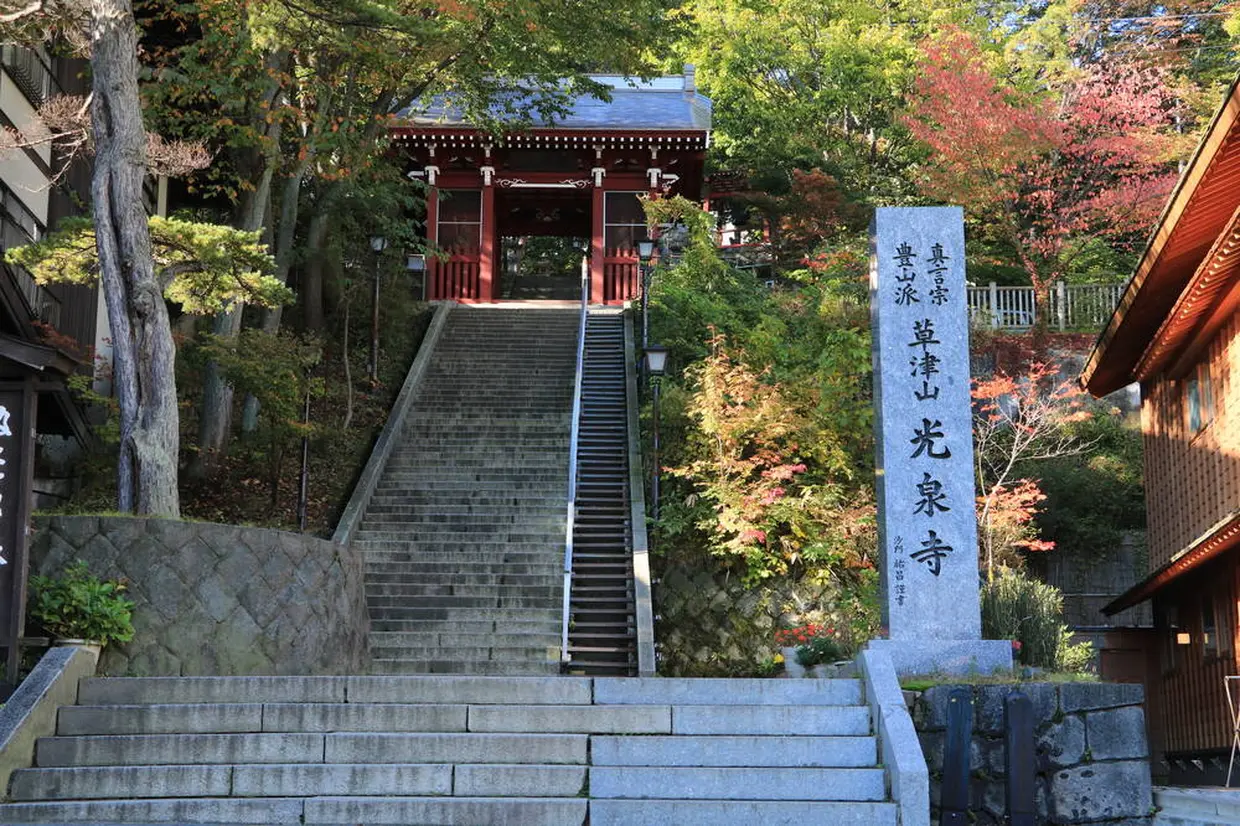
Kosenji Temple, located on a hill overlooking Yubatake, is a historic temple dedicated to Yakushi Nyorai. The Yakushi Nyorai has long been famous as one of Japan’s three great hot spring medicinal herbs, and is said to bring blessings for good health and healing of illness.
Shirane Shrine (白根神社)

Shirane Shrine, a 5-minute walk from Yubatake, is dedicated to the deity Yamatotakeru no Mikoto, one of the legendary figures associated with the opening of Kusatsu Onsen, and is worshipped by the local people. Every year on July 17 and 18, the Shirane Shrine Festival is held and the town comes alive.
Sainokawara Street to Sainokawara Park area
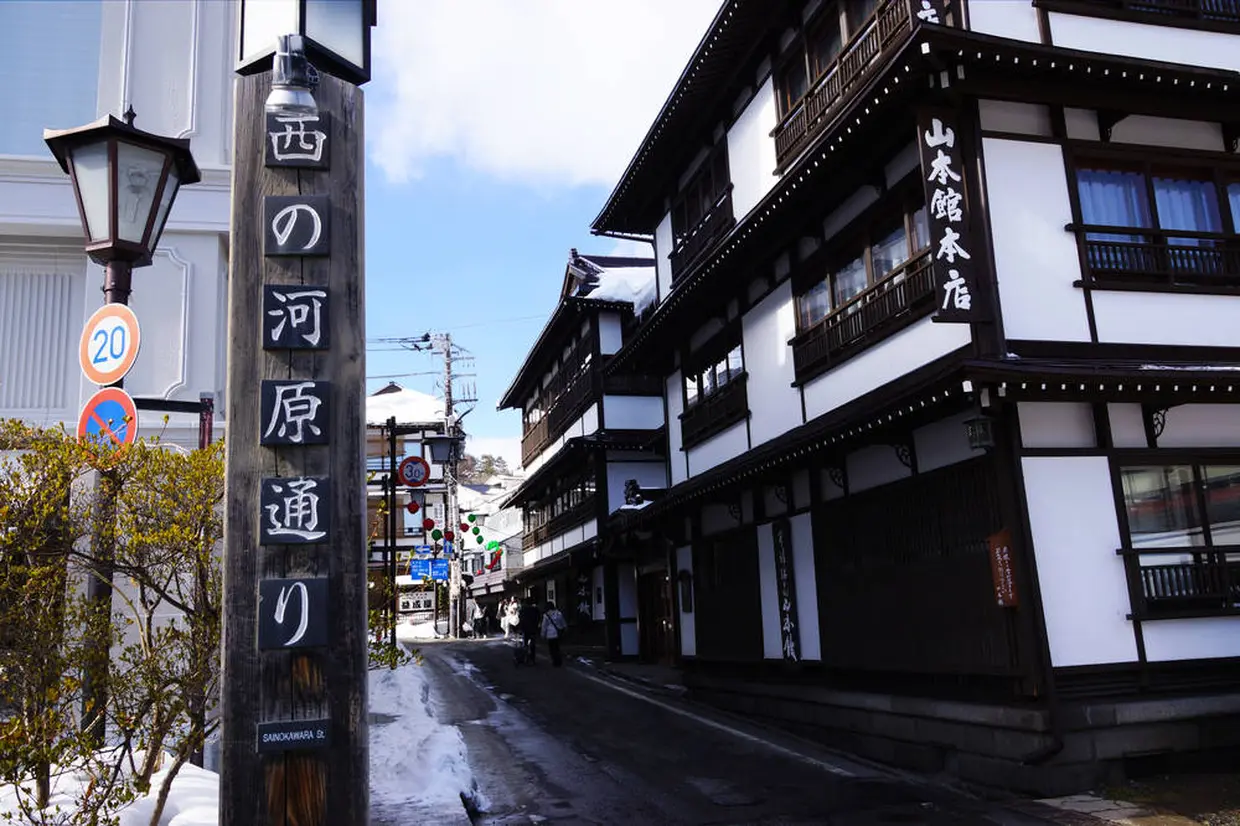
Running east to west through Kusatsu Onsen from Yubatake to Sainokawahawa Park, Sainokawara Street is lined with inns, hotels and other lodging facilities, souvenir stores, restaurants, and many more. It is a perfect area to stroll around Kusatsu Onsen, stopping at various stores.
When you arrive at Sainokawahawa Park, you will find hot springs flowing out from various places in the park. This is a spot rich in nature, so please feel the power of the hot springs, a blessing of the earth, as you explore the park.
Teuchi-Soba, Shokuji, Sake Aoyama (手打蕎麦・食事・酒 あおやま)
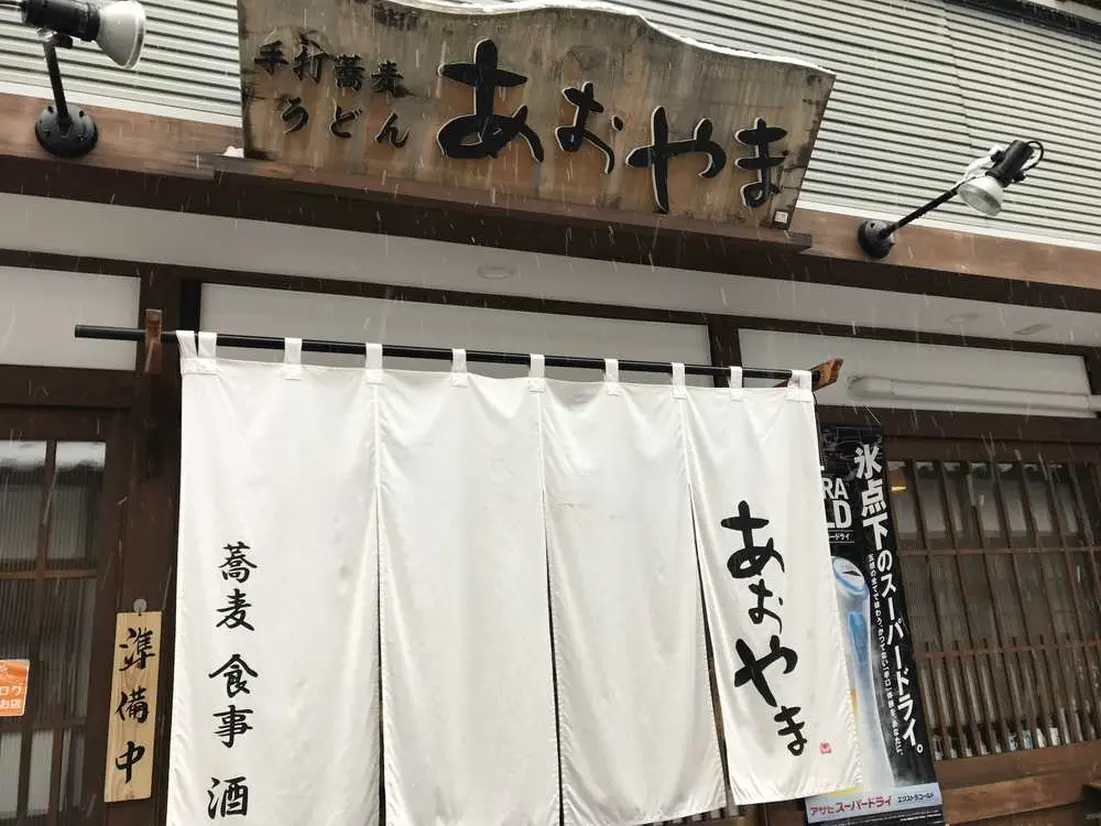
Aoyama, located just off Sainokawara Street leading from Yubatake to Sainokawara Park, is proud to serve handmade soba noodles. Only carefully selected buckwheat flour from Shinshu area, the home of buckwheat noodles, is used, and the ratio of flour is of 9 to 1, making use of the original ingredients and texture of the buckwheat.
Maitake mushroom soba and maitake tempura rice bowls are used with maitake mushrooms from the local area and nearby Village. Other snacks and local alcoholic beverages are also on the menu.
Yuagari Karinto (湯あがりかりんと)

Walk along Sainokawara Street from Yubatake to Sainokawara Park, and on the left side of the street you will find Yuagari Karinto, which sells karinto (a Japanese deep fried brown sugar snack) with a variety of flavors. There are 28 different flavors to choose from, making for a wide selection. The colorful Japanese-style packages, which resemble yukata (Japanese summer kimono), are cute and make great souvenirs.
In addition to karinto, you can also enjoy “Yuagari Joshu Wagyu Man,” a beef meat bun richly flavored with Joshu beef, which is a must-try.
Kusatsu Glass Warehouse
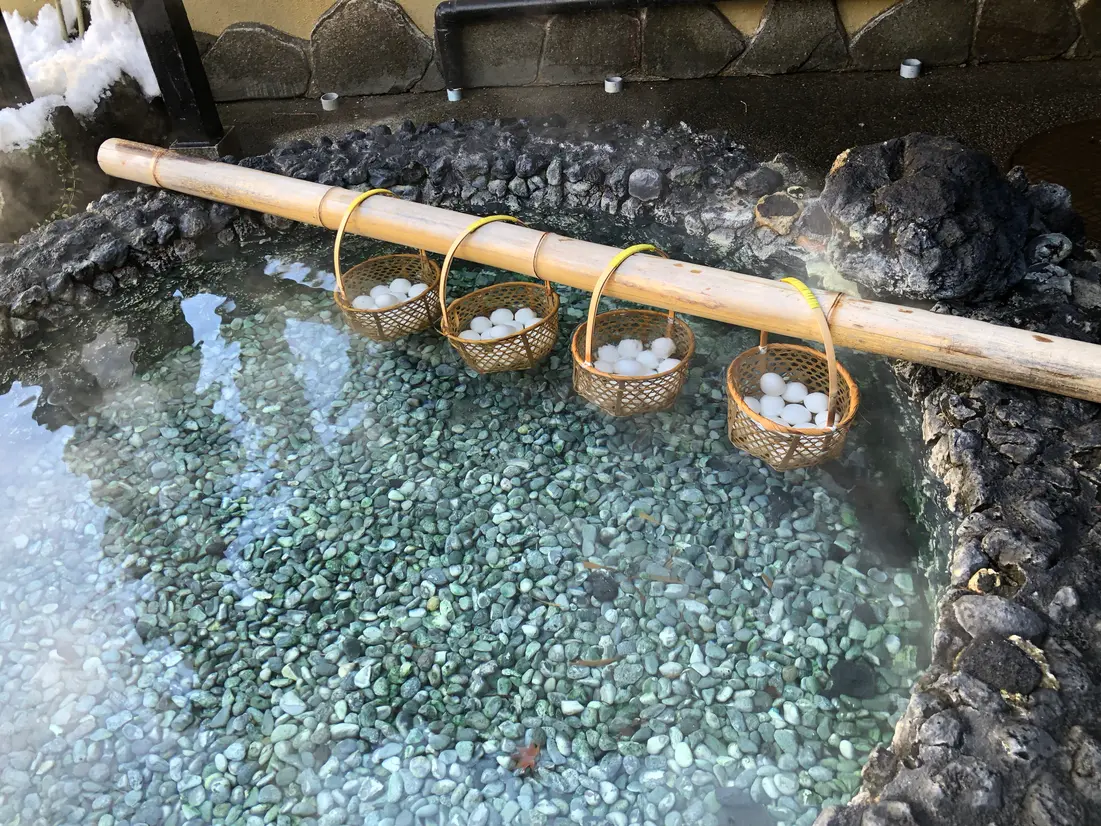
The Kusatsu Glass Warehouse, located along Sainokawara Street, a 10-minute walk from the Kusatsu Onsen Bus Terminal, sells a variety of glassware, from emerald green “Kusatsu Onsen Glass” to glass containers, accessories, key chains and other small items.
There are three buildings in a row from Building No. 1 to No. 3, and in Building No. 2, visitors can experience tonbo dama (glass beads) creation. Instructors will teach you how to make them, so you can participate without worries. Try making your own original work of art as a memory of your trip.
Also, at the entrance of Building No. 1, visitors can see eggs in baskets soaking in hot spring water. These are “onsen tamago” (hot spring eggs), a specialty of the Glass Warehouse, and you can taste freshly cooked half-boiled eggs made with hot water from the hot spring.
Sainokawara Park (西の河原公園)
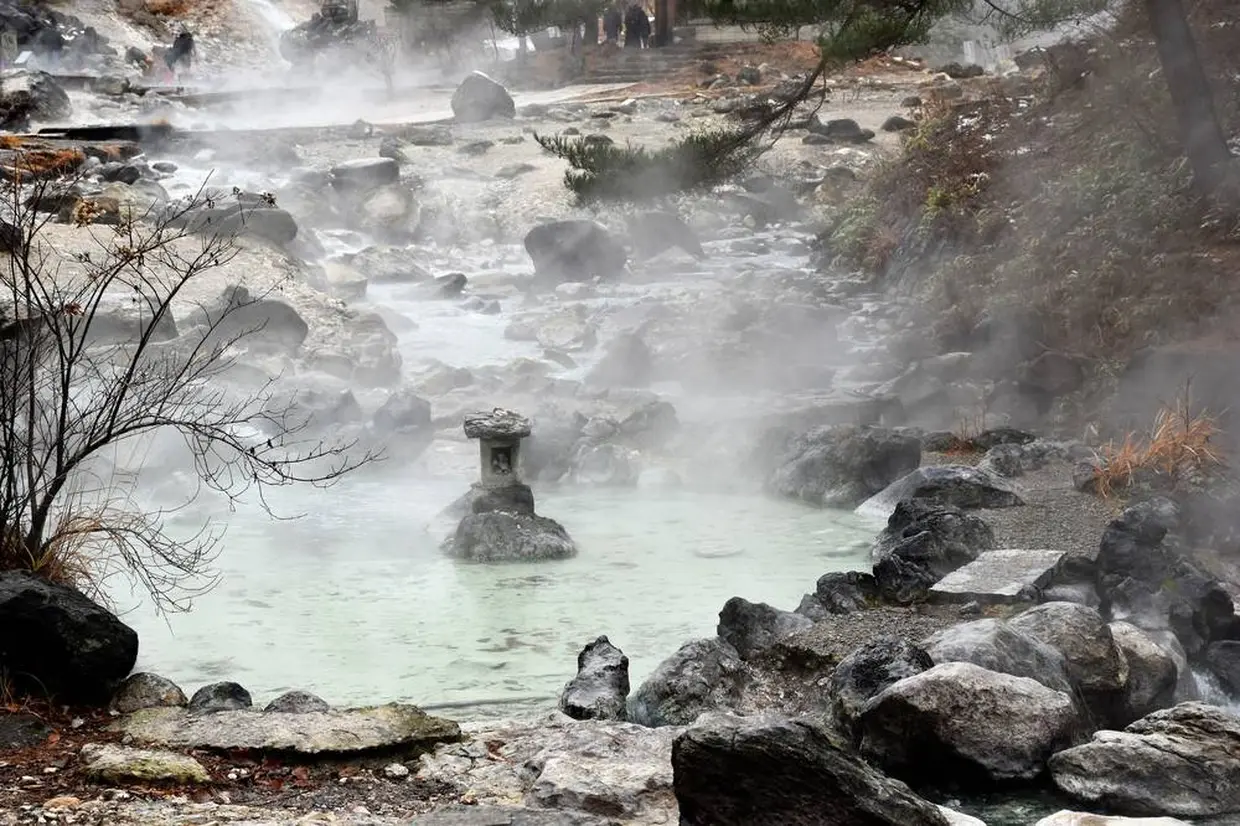
The park is about a 10-minute walk from Yubatake along Sainokawahawa Street. The park was originally the location of the Sainokawara hot spring source, where rocks and stones were strewn about and hot spring water bubbled up from everywhere.
In recent years, with the increase in the number of tourists, a promenade, footbaths, and a visitor center have been built and maintained as a park. The Visitor Center introduces the relationship between the volcanoes and hot springs around Kusatsu, the plants and animals, and its history through photos and videos, etc. It takes about 20 minutes to tour the park, so please stop by for a break as well.
And on a small hill in the middle of the park stands a bust statue of Dr. Baelz and Dr. Scriba. Dr. Baelz was a famous German medical doctor who came to Japan as a professor at the University of Tokyo during the Meiji era (1868-1912) and was an avid researcher of onsen therapy. He was a frequent visitor to Kusatsu Onsen and introduced it to the world. Together with Dr. Baelz, Dr. Scriba also contributed greatly to modern medicine in Japan.
Other monuments to literary figures can also be seen as you stroll through the park. Walking to the back of the park, you will arrive at Sainokawara Rotenburo (open air bath).
Kusatsu Anamori Inari Shrine (草津穴守稲荷神社)
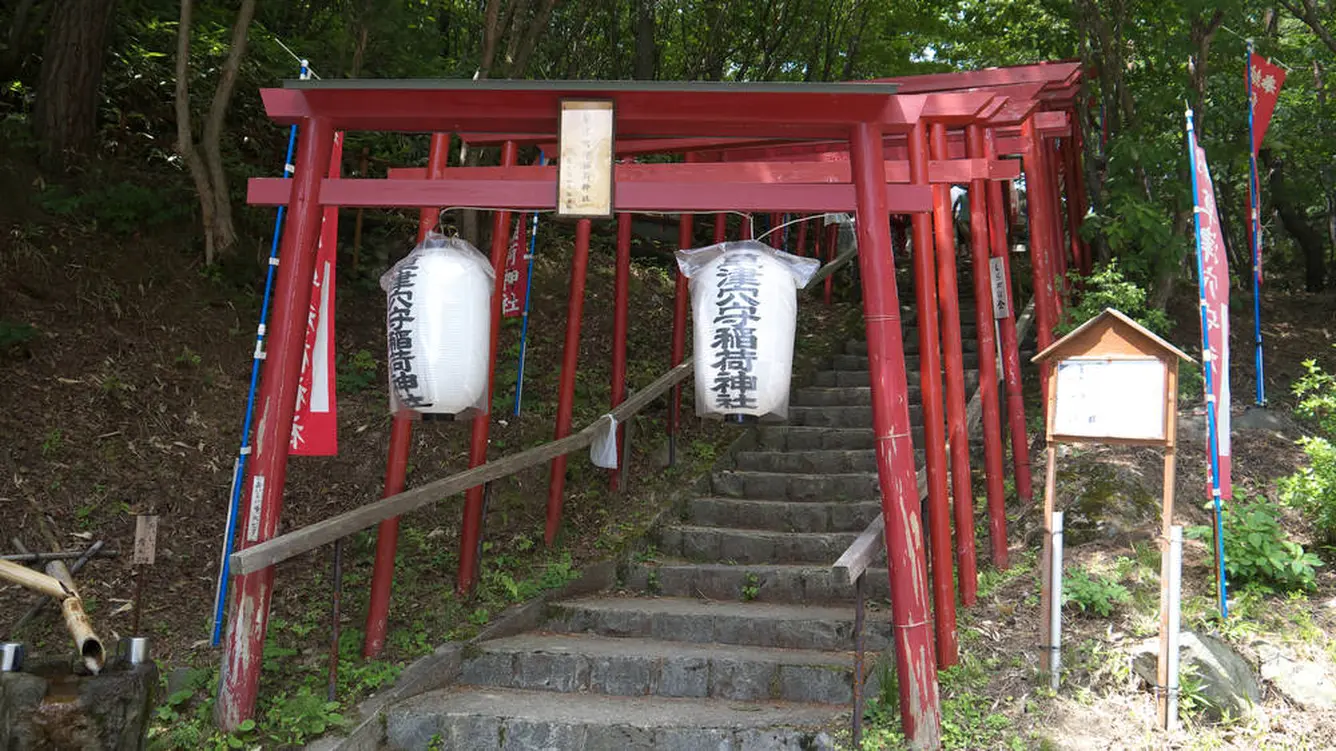
Kusatsu Anamori Inari Shrine, located in Sainokawara Park, is a branch of Anamori Inari Shrine near Haneda Airport. Around 1907, the owner of the Yamazaki Dyeing Shop in Tokyo went to Kusatsu Onsen and was successfully cured of his illness, and the Anamori Inari Shrine, which he had always believed in, was annexed to this location.
The deity is Toyoukehime-no-Mikoto, who is believed to bring various benefits.
Every year in September, priests from Anamori Inari in Haneda visit the shrine to hold a festival, which attracts a large number of local residents and visitors.
Oni no Sumo Ba Hi (鬼の相撲場碑)
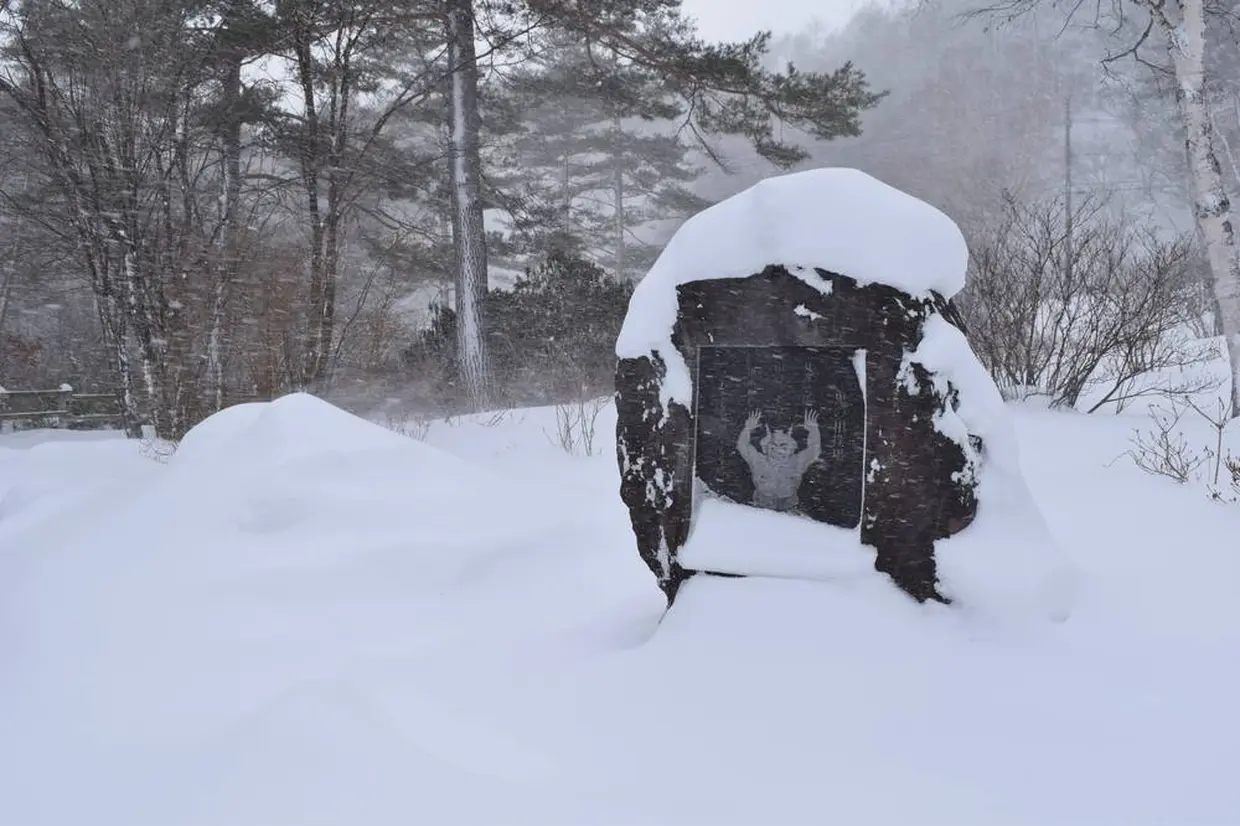
The area around Sainokawara Park was once feared and called “Oni no Sensui” (demon’s springs) because of the hot springs gushing out from all over the place. There is also a place in the valley of Tengu Mountain in one corner of the park named “Oni no Sumo Ba (sumo ring of demon)”, where a monument has been erected.
There is an old story that demons in need of a place to play were allowed to play on the Sainokawara on the promise that they would stop misbehaving in the village, and demons used to wrestle at this place.
About 3,000 azaleas grow in the surrounding area, and the best time to view them is around early June every year. Why not take a break and spend some time relaxing?
Sainokawara Rotenburo (西の河原露天風呂)

Sainokawara Rotenburo (West Riverside open-air bath), located at the back of Sainokawara Park, draws hot water from the Bandai source. The combined size of the men’s and women’s baths is 500 square meters, one of the largest in Japan, and the open-air baths are surrounded by nature. Visitors can enjoy the hot spring baths while feeling the seasonal scenery and the highland breezes.
There are no washrooms, but there are separate changing rooms, lockers, and toilets for men and women. At night, visitors can gaze at the stars in the night sky while bathing in the hot spring.
Otakinoyu Surrounding Area
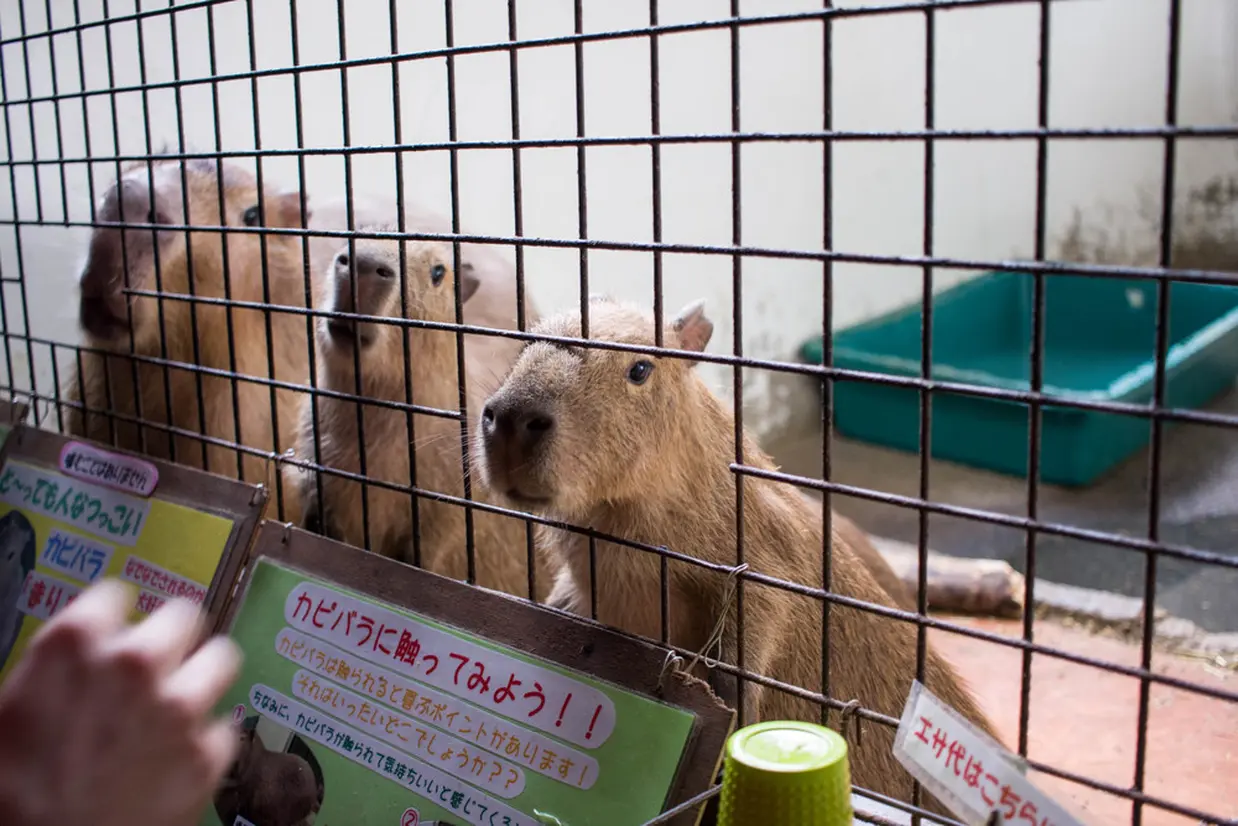
The area is about a 15-minute walk from the Kusatsu Onsen Bus Terminal, and about a 10-minute walk from Yubatake through Yutaki to the east on Takishita Street. The area is home to Otaki-no-yu, which utilizes one of Kusatsu Onsen’s representative springs, the Nikawa Spring Source. There is also the Kusatsu Tropical Wonderland, where subtropical animals and plants are bred and cultivated using hot spring heat.
Otaki no Yu (大滝乃湯)
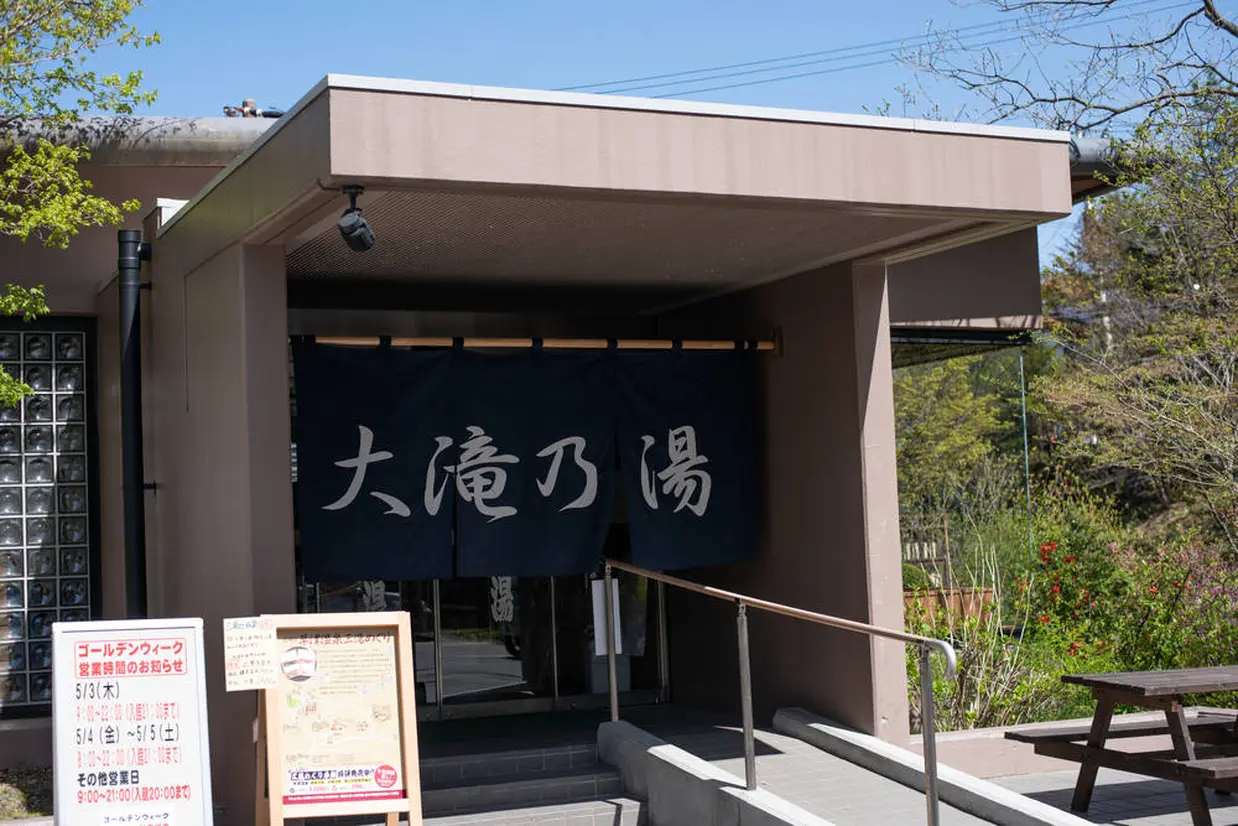
Kusatsu Onsen boasts an abundance of hot water, and it is said that there are as many as 100 sources within the town of Kusatsu. Of these, Otaki-no-yu offers the luxury of hot water from the Nikawa source, which is characterized by its high temperature and softness.
Here, the traditional Kusatsu hot spring baths are provided for both men and women. The bathtubs have different temperatures, and visitors enter the bathtubs in order, starting with the lowest temperature.
A restaurant is also located inside the facility. Visitors can enjoy a variety of dishes centering on noodles, including Himokawa udon (super wide udon noodles) using with Joshu pork produced in Gunma Prefecture. You can also use the restaurant only for meals.
Kusatsu Tropical Wonderland (草津熱帯圏)
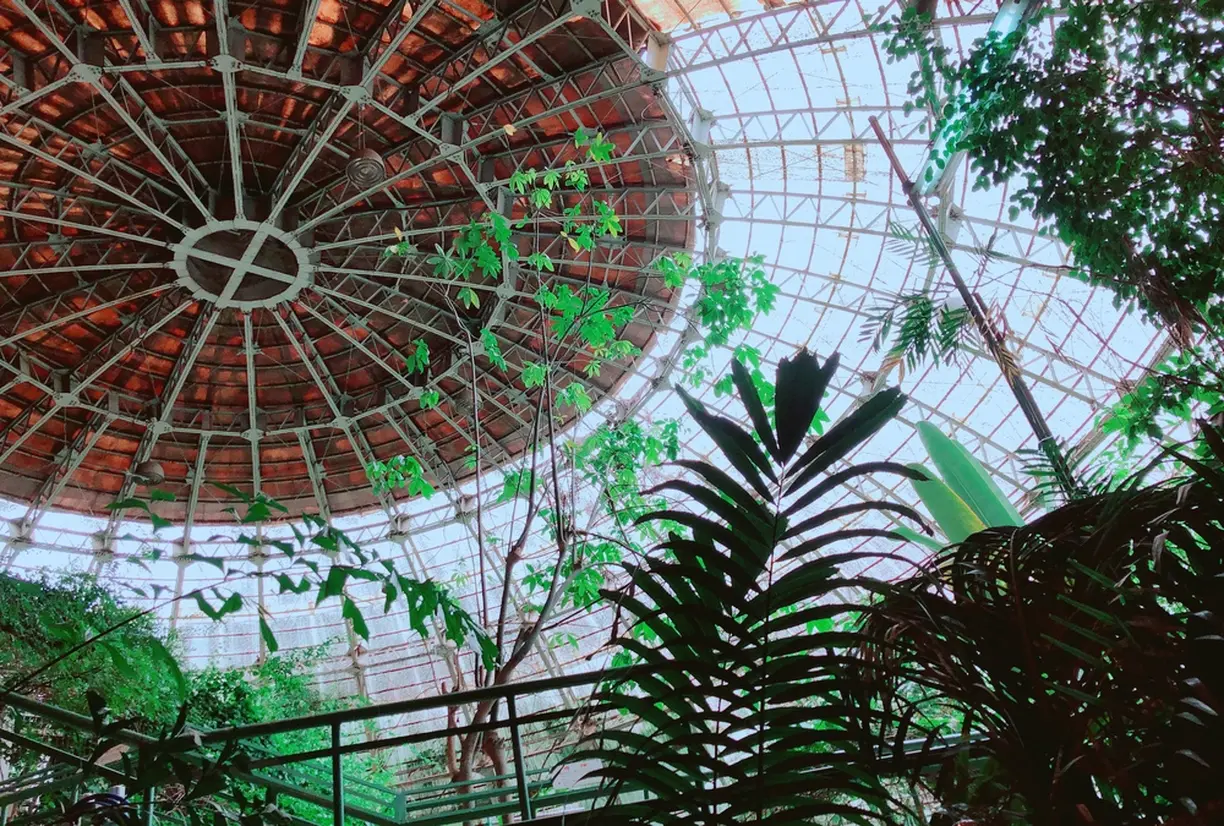
Kusatsu Tropical Wonderland is a zoo located at the highest altitude in Japan. In Monkey Paradise, where Japanese macaques are kept, and in the huge 15-meter-high dome, the heat from the hot springs of Kusatsu Onsen is used to grow plants that live in the subtropical and tropical zones, and animals are bred and exhibited in these areas.
Grandefiume kusatsu (グランデフューメ草津)
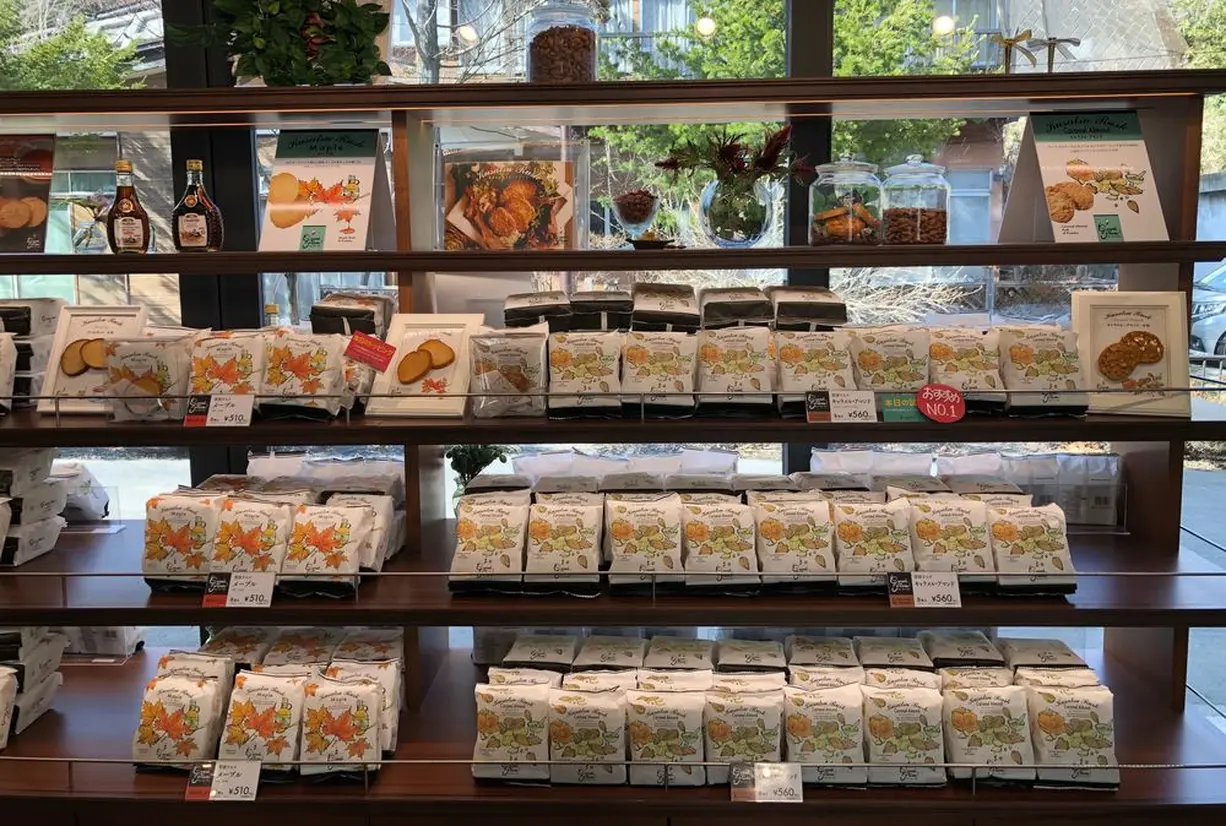
Grandefiume kusatsu is a restaurant where you can enjoy Kusatsu rusk and Italian soft gelato. The Kusatsu rusk is an original product made with a special blend of several types of flour to create a crispy texture, and there are several varieties, from plain, maple, and other sweet-tasting rusks to garlic-flavored ones that are perfect as a snack with drinks.
The store’s No. 1 seller is “Caramel Amand” made with luxurious sliced almonds and coated with caramel. The cute illustration on the package makes it a perfect souvenir from Kusatsu Onsen as well as a treat for yourself or a gift.
Inside the restaurant, you can also enjoy buffet-style Italian soft gelato, which combines the smoothness of soft-serve ice cream with the richness of gelato. You can customize and enjoy your own original taste by topping your favorite gelato with rusks and sauces. It is also great that there is no time limit for all-you-can-eat.
Other Areas
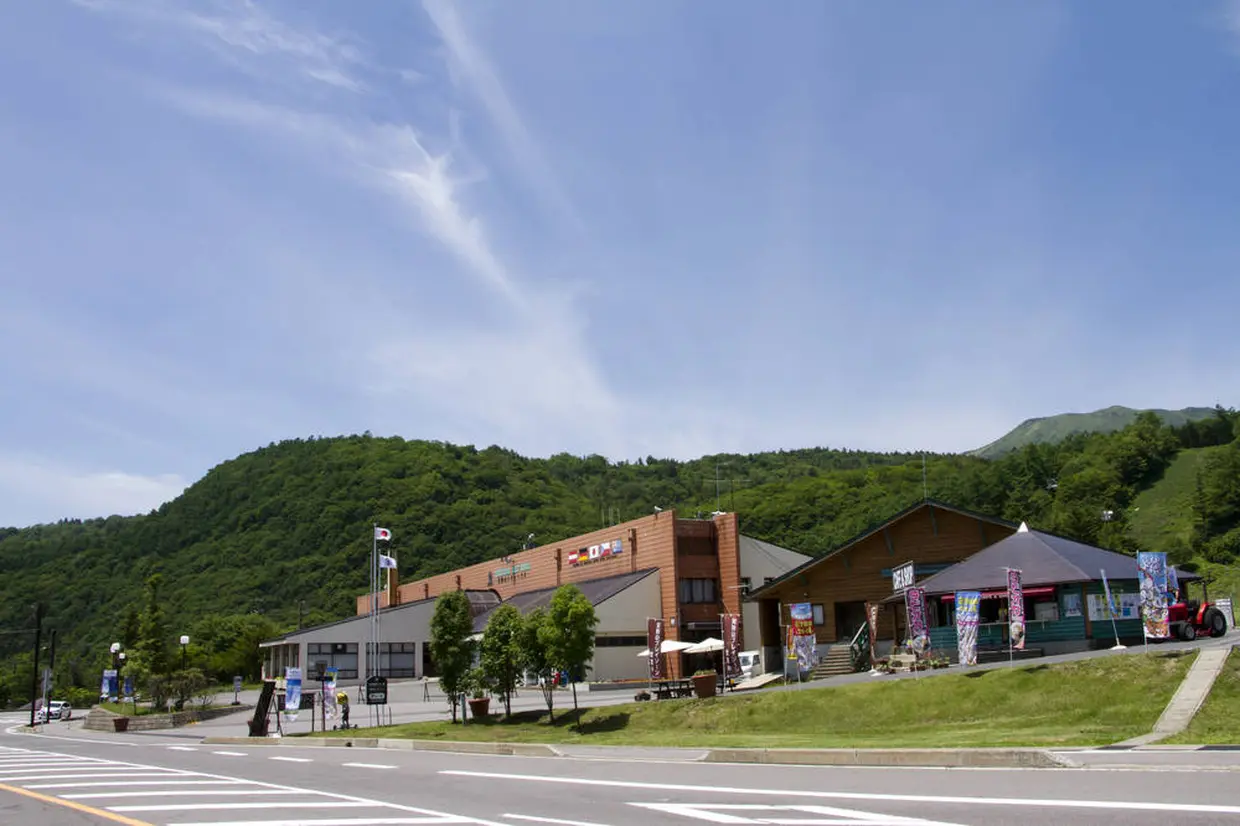
A short distance from Kusatsu Onsen Town centering on Yubatake, there are many spots where you can experience the spectacular natural beauty of the Kusatsu Plateau close at hand. Please add various ways to enjoy your trip, such as enjoying seasonal activity sports and admiring nature in each of the four seasons.
Tenguyama Play Zone

Kusatsu Onsen Ski Resort is a 5-minute drive from the Kusatsu Onsen Bus Terminal, where you can enjoy winter sports on the finest powder snow. When there is no snow, the Tenguyama Play Zone is open on the 1,300-meter-high Kusatsu Tenguyama, where you can enjoy a variety of active sports.
The park can be used for multiple purposes, including activities such as zip-lining, mountain carts, mini golf, and playing soccer and badminton in the plaza.
Mononugu Pond (武具脱の池)
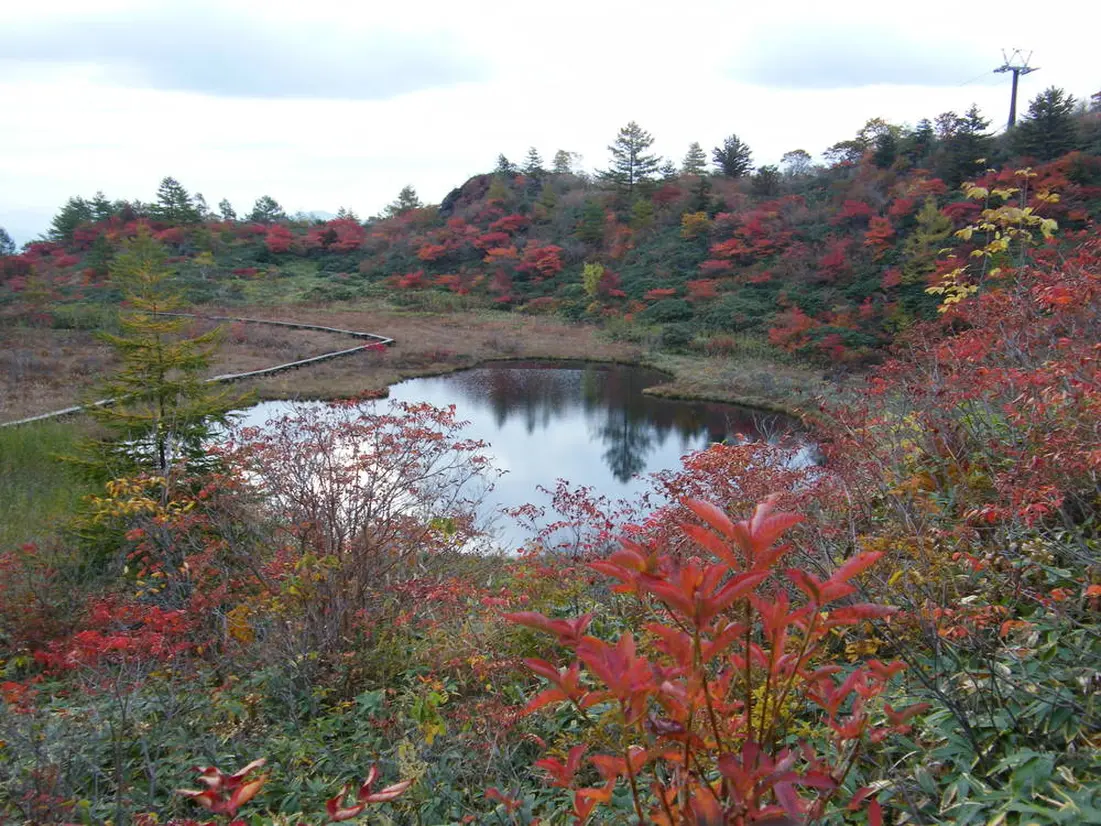
About 15 minutes from Kusatsu Onsen town, you will arrive at the Kusatsu parking lot located on the Kusatsu Sesshogawara. From there, a 5-minute walk will take you to Mononugu Pond.
It is named after a legend that the remnants of Kiso Yoshinaka, who was once chased by Minamoto no Yoritomo, took off his armor at this place.
Around the pond, there is a variety of plants, and the scenery changes with the seasons. A hiking course from the Tenguyama Lodge at the Kusatsu Onsen ski resort to the Mononugu Pond is also maintained.
Roadside Station Kusatsu Undo Jaya Park (道の駅 草津運動茶屋公園)

If you are planning to drive to Kusatsu Onsen, Roadside Station Kusatsu Undo Jaya Park is conveniently located at the entrance to Kusatsu Onsen. The information center in the facility provides not only tourist information on Kusatsu Onsen, but also road conditions in the surrounding area, ski resort information, and other useful travel and driving information.
Also, there is a wide selection of souvenirs from Kusatsu Onsen, Gunma’s specialties, original products, and even local foods. It is a good place to choose souvenirs on the way back from a trip to Kusatsu Onsen or to enjoy them as the end of your trip.
Osen Waterfall (嫗仙の滝)

Osen Waterfall is located in the southeast of Kusatsu Town and is a beautiful waterfall with delicate white water splashing down the brown rock surface surrounded by greenery. A giant katsura tree, 35 meters high with a trunk circumference of 6.7 meters, towers beside the waterfall and has been selected as one of the “100 Giants of the Forest” by the Forestry Agency.
It takes about 15 minutes by car from the Kusatsu Bus Terminal and about 10 minutes by car from the hot spring resort to reach the parking lot of Osen Waterfall. From there, it is about a 30-minute walk along the promenade to the base of the falls. The path is hilly and has steep slopes along the way, so please be careful with your footing. It is recommended to wear comfortable walking shoes and clothes.
Yoshigadaira Wetlands (芳ヶ平湿地群)

Yoshigadaira wetlands, which stretches across Kusatsu and Nakanojo towns, was formed by the volcanic activity of Kusatsu-Shiranesan volcano.
In order to preserve and utilize this globally precious nature, it was registered as a wetland under the Ramsar Convention in 2015. The trail is well maintained, and it takes about 30 minutes by car from the Kusatsu Onsen Bus Terminal to the Chatsubomi Moss Park, a hidden gem in wetlands.
Access to Kusatsu Onsen and required time
The town of Kusatsu, where Kusatsu Onsen is located, is situated on a plateau about 1,200 meters above sea level in the northwestern part of Gunma Prefecture. Therefore, the main access to Kusatsu Onsen is by train from nearby cities such as Tokyo to the nearest station and transfer to a bus, or by car or highway bus.
By train
The nearest station for a trip to Kusatsu Onsen is Karuizawa Station for the Shinkansen bullet train, or JR Naganohara-kusatsuguchi Station for the conventional train. From there, take a local bus to the Kusatsu Onsen Bus Terminal.
Required time to Karuizawa Station
- From Tokyo and JR Tokyo Station: Approx. 1 hour and 20 minutes by JR Hokuriku Shinkansen
- From JR Omiya Station, Saitama Prefecture: Approx. 50 minutes by JR Hokuriku Shinkansen
- From JR Niigata Station, Niigata Prefecture: Approx. 1 hr. 15 min on JR Joetsu Shinkansen to Takasaki Station, and approx. 20 min on the JR Hokuriku Shinkansen from Takasaki Station to Karuizawa Station.
- From JR Nagano Station, Nagano Prefecture: Approx. 30 min to Karuizawa Station on the JR Hokuriku Shinkansen.
- From Ishikawa prefecture, JR Kanazawa Station: Approx. 2 hrs 10 min on JR Hokuriku Shinkansen to Karuizawa Station.
From Karuizawa Station, take the KusakaruKotsu Bus or Seibu Kanko Bus and get off at the Kusatsu Onsen Bus Terminal; Required time is around 55 minutes to 1 hour and 18 minutes.
Required time to Naganohara-Kusatsuguchi Station
- From Tokyo, JR Tokyo Station: Approx. 1 hour on the JR Joetsu Shinkansen to Takasaki Station, and from Takasaki Station to Naganohara-Kusatsuguchi Station on the JR Azuma Line, approx. 1 hour and 35 minutes.
- From JR Ueno Station, Tokyo: Approx. 2 hours and 30 minutes by limited express Kusatsu.
- From JR Omiya Station, Saitama Prefecture: Approx. 30 min. on the JR Joetsu Shinkansen and Hokuriku Shinkansen to Takasaki Station, and from Takasaki Station to Naganohara-Kusatsuguchi Station on the JR Azuma Line, approx. 1 hr. 35 min.
- From JR Niigata Station, Niigata Prefecture: Approx. 1 hr. 15 min. on the JR Joetsu Shinkansen to Takasaki Station, and from Takasaki Station to Naganohara-Kusatsuguchi Station on the JR Azuma Line, approx. 1 hr. 35 min.
Take a JR bus from Naganohara-Kusatsuguchi Station and get off at Kusatsu Onsen Bus Terminal: about 25 minutes
Highway Bus to Kusatsu Onsen
From Tokyo, you can also travel to Kusatsu Onsen by highway bus. Although it takes longer than the Shinkansen, there is no need to change trains. One-way fare is about 3,500 yen, which is cheaper than the Shinkansen. JR buses also offer discounts for round-trip, online payment, and early purchase, so it is recommended to purchase in advance once you have decided on your travel plans.
Required time
- From Shinjuku Bus Terminal, Tokyo: Approx. 4 hours to Kusatsu Onsen Bus Terminal (JR Bus Kanto Joshu Yumeguri-go)
- From Tokyo Station Yaesu Street, Tokyo: Approx. 5 hours to Kusatsu Onsen Bus Terminal (JR Bus Kanto Tokyo Yumeguri-go)
- From Shibuya Mark City, Tokyo: 4 hours and 40 minutes to Kusatsu Onsen Bus Terminal (Tokyu Transsés)
Introducing Kusatsu Onsen Bus Terminal and the nearest stations: Karuizawa Station and Naganohara-Kusatsuguchi Station
Kusatsu Onsen Bus Terminal (草津温泉バスターミナル)

The Kusatsu Onsen Bus Terminal is served by buses from Karuizawa Station in Nagano Prefecture and Naganohara-Kusatsuguchi Station in Gunma Prefecture, highway buses from the Tokyo area, one-coin buses that tour the town, and shuttle buses connecting to the ski resort. It is also the starting point for travelers visiting Kusatsu Onsen by train or highway bus.
On the third floor is the Kusatsu Town Library, which houses a museum and library where visitors can learn about the history of Kusatsu Onsen. There is also a footbath in front of the terminal that can be used free of charge 24 hours a day. You can also spend time here after getting off the bus or while waiting.
Karuizawa Station (軽井沢駅)

Karuizawa Station, located about one hour by bus from the Kusatsu Onsen Bus Terminal, is the closest station to Kusatsu Onsen from the Nagano Prefecture side. It is one of the stations on the Hokuriku Shinkansen Line, so it is convenient if you are visiting Kusatsu Onsen from the Tokyo or Ishikawa Prefecture side.
On the south exit side of the station is the Karuizawa Prince Shopping Plaza, a huge shopping mall. The retro-style “Shinano Railway Karuizawa Station Old Station Building” stands at the north exit. This building is the former Karuizawa Station Building, which was demolished when the Shinkansen bullet train started operations, and was restored as a station building by Shinano Railway. Furniture designed by Mitooka is arranged to match the exterior and interior of the old building, which has high historical value.
After returning from Kusatsu Onsen, take a walk around the area or add shopping to your travel plans.
Naganohara-Kusatsuguchi Station (長野原草津口駅)
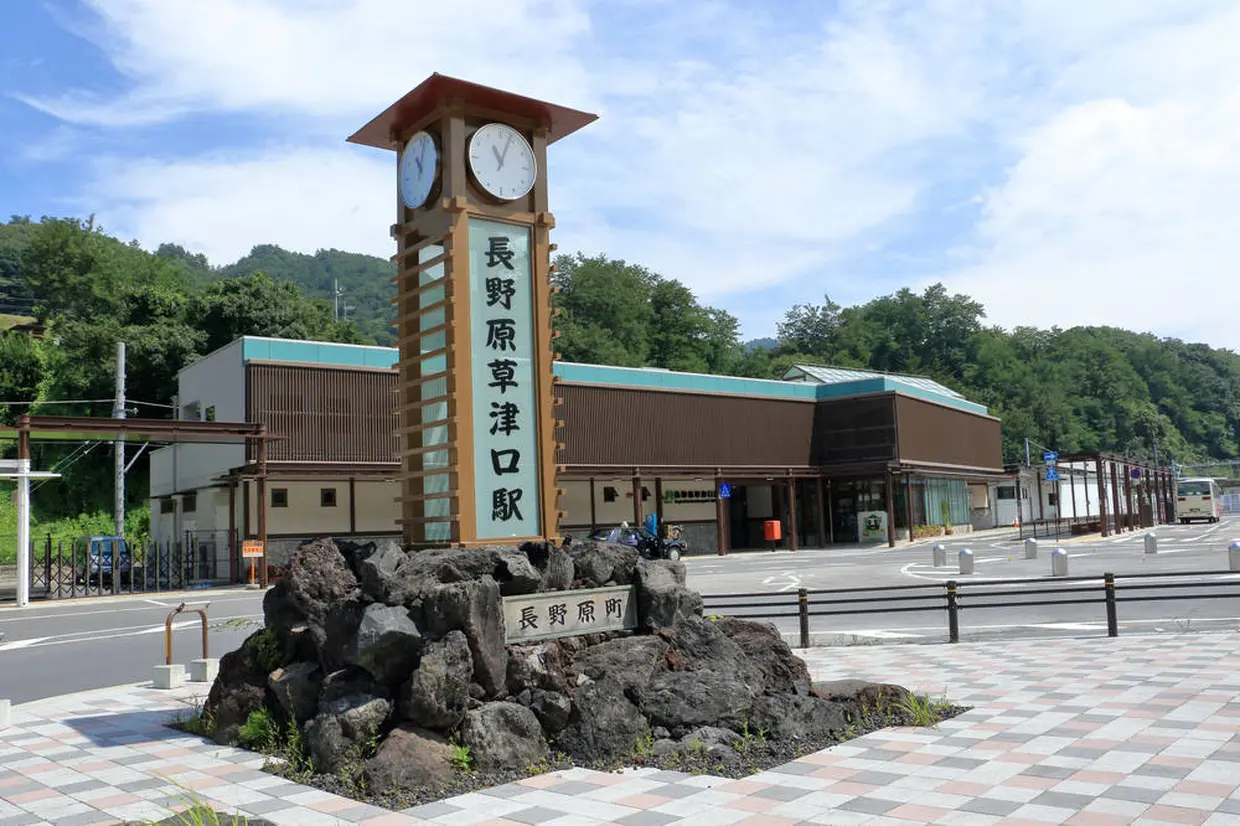
If you take the Joetsu Shinkansen or Hokuriku Shinkansen and transfer to a local train at Takasaki Station to go to Kusatsu Onsen, or if you take the limited express Kusatsu from Tokyo Ueno to Kusatsu Onsen, the nearest station is Naganohara-Kusatsuguchi Station. From the station, transfer to a JR bus, which will take you to the Kusatsu Onsen Bus Terminal in about 25 minutes.
Transportation for Kusatsu Onsen Sightseeing
Walking
It takes about 5 minutes on foot from the Kusatsu Onsen Bus Terminal to Yubatake, located in the center of the hot spring resort area, and about 10 minutes from Yubatake to Sai-no-Kawara Park on Sai-no-Kawara Street. If your sightseeing is centered on Yubatake, we recommend walking around the area.
Taxi
If you want to go to a sightseeing spot that is a little far from the center of town or if you have a lot of luggage, you may want to take a taxi. Taxi companies offer course plans and chartered taxi in which drivers who are familiar with the local area guide you around the tourist spots. This is also convenient for sightseeing with several people.
One coin bus
It is a bus that travels around a town, and each of the four routes takes 30 minutes for one round. However, only the A route takes you to major tourist places such as Yubatake and Sai-no-Kawara Park.
The buses are operated by two green-bodied retro buses and one wheelchair-accessible bus. Tourists are welcome to use the buses, but please be courteous to each other and observe good riding manners, as the buses were originally designed for welfare purposes. Please note that luggage should be no larger than the size of a knee-lift, and passengers are not allowed to board the buses with large luggage.
Great value free tickets
small three-yu tour ticket (ちょいな三湯めぐり手形)
You can enter each of the three hot springs in Kusatsu Onsen, Gozanoyu, Otakinoyu, and Sainokawara open-air bath, once each. With this ticket, you can save more than 500 yen off the total of the regular bathing fee, and it has no expiration date. You can also send it as a postcard by writing your name and affixing a stamp. If you are not able to visit all of the baths, you can send a postcard to someone close to you.
Where to buy?:Gozanoyu, Otakinoyu, Sainokawara open-air bath
Expiration date:No expiry date*Age restrictions apply to children’s fee.
[Official website] https://onsen-kusatsu.com/tickets/
Special Offers (草津温泉観光協会日帰り入浴お楽しみクーポン)
Access the following URL on the “Yu Love Kusatsu” website of the Kusatsu Onsen Tourism Association to get a fun coupon for discounted admission to hot spring facilities where you can enjoy bathing in Kusatsu Onsen. The coupon can be used at Atsu-no-yu, Otaki-no-yu, Kusatsu Tropical Wonderland, etc. Please display the screen you accessed to use the coupon.
[URL] https://www.kusatsu-onsen.ne.jp/cp/index.php
Frequently Asked Q&A
How long does it take from Tokyo by train?
Kusatsu Onsen is located in Gunma Prefecture, but close to Nagano Prefecture. You will need to take the Shinkansen bullet train, a conventional JR line, or a local bus to get there. The ride from Tokyo Station via Karuizawa Station takes about 2 hours and 40 minutes, while the ride via Naganohara-Kusatsuguchi Station takes about 3 hours. Both of these routes require time for transits, so please allow plenty of time for your trip.
How is the climate in Kusatsu Onsen?
The highland climate is pleasant, with an average annual temperature of 7°C (45°F), and even in mid-summer the temperature rarely rises above 25°C (77°F). In winter, powdery snow falls and winter sports such as skiing can be enjoyed. Please note that roads may be impassable in winter due to icy or snowy conditions.
How many nights would be most enjoyable?
If you are planning to sightsee mainly in the hot spring resort area, you can fully enjoy your stay for two days and one night because of the concentration of sightseeing spots. If you want to enjoy leisure activities such as hiking, trekking, and winter sports, you may want to stay two nights to give yourself more time.
